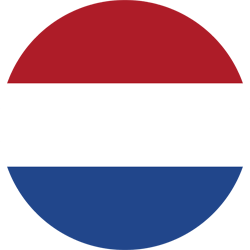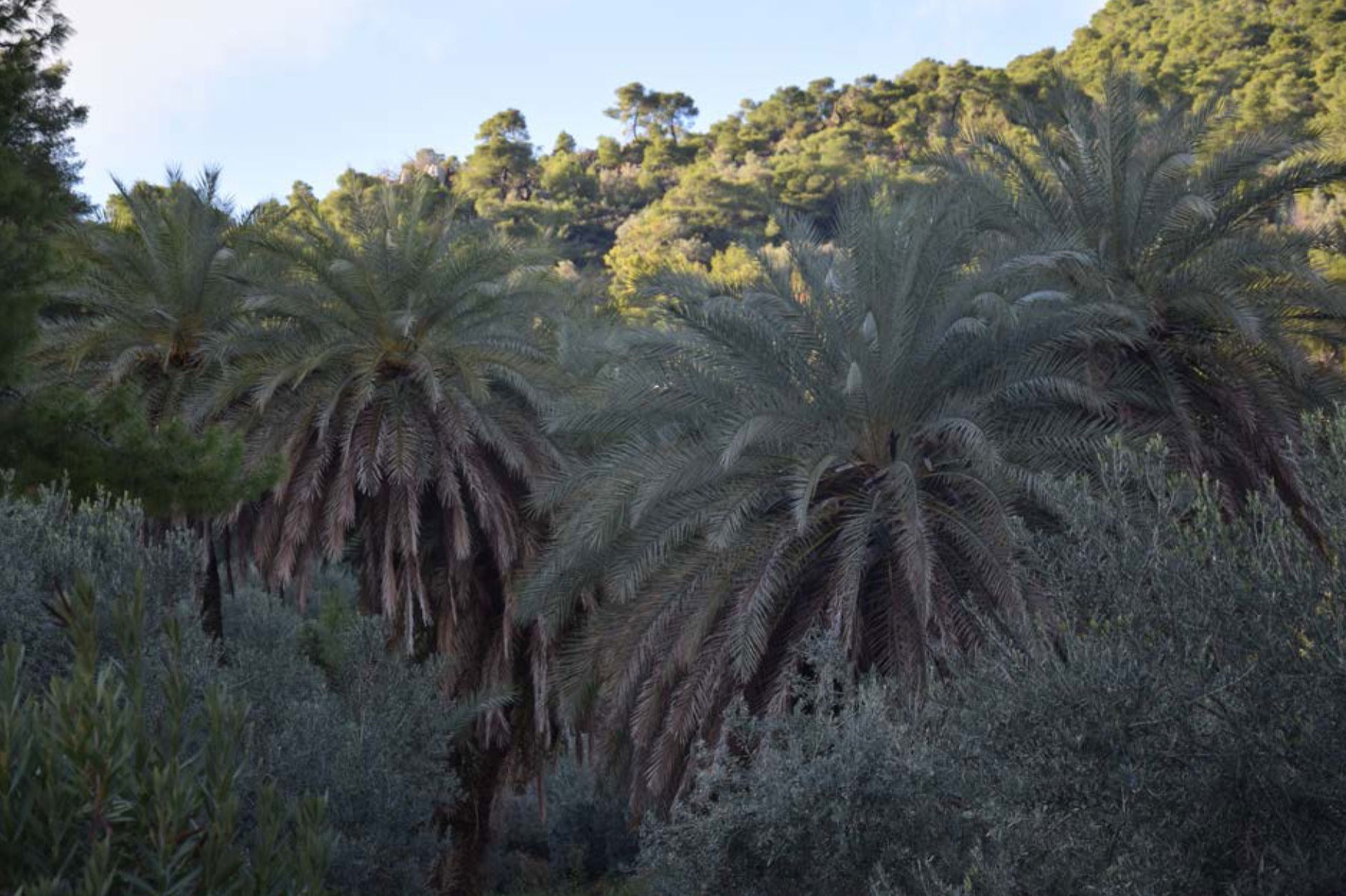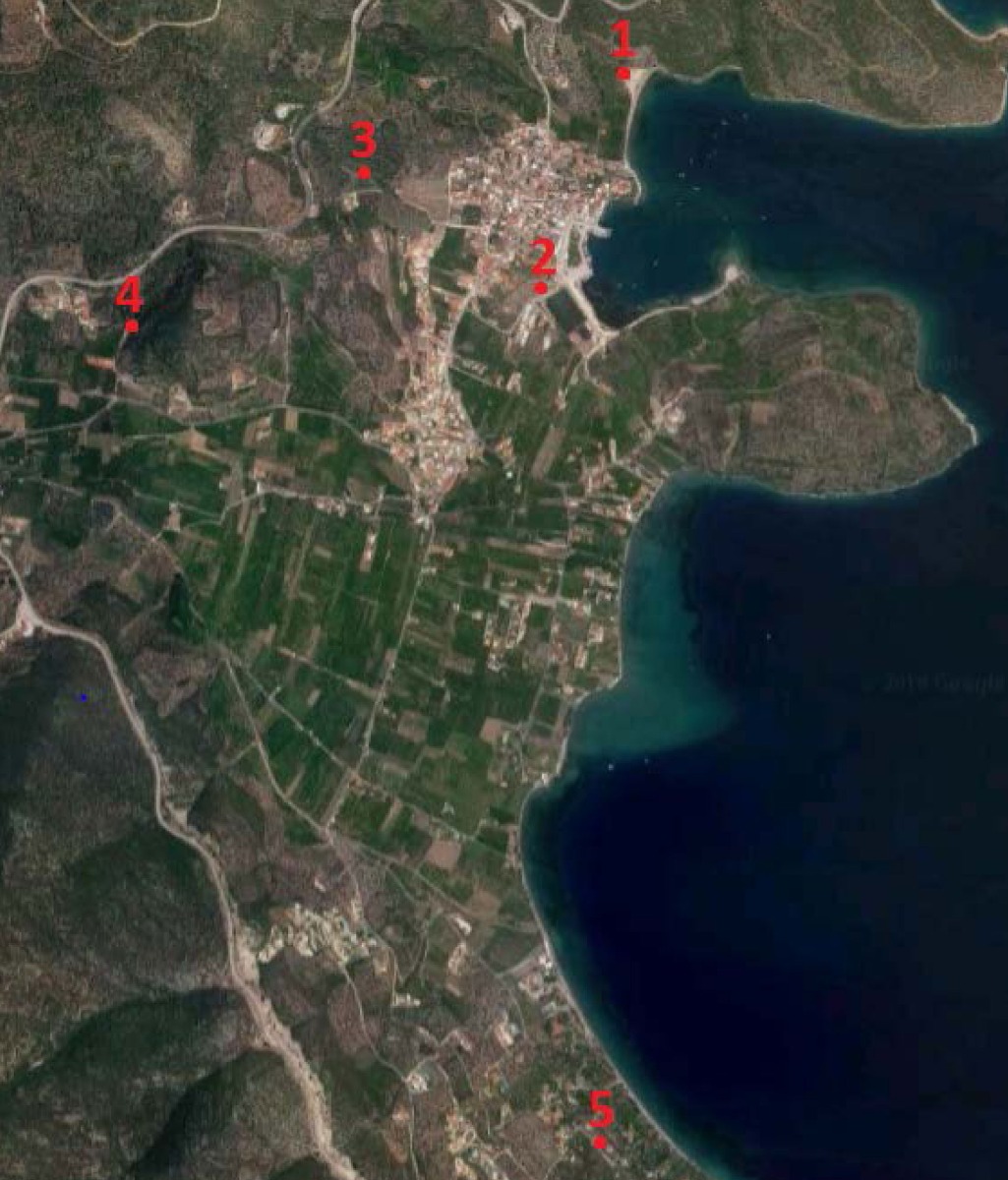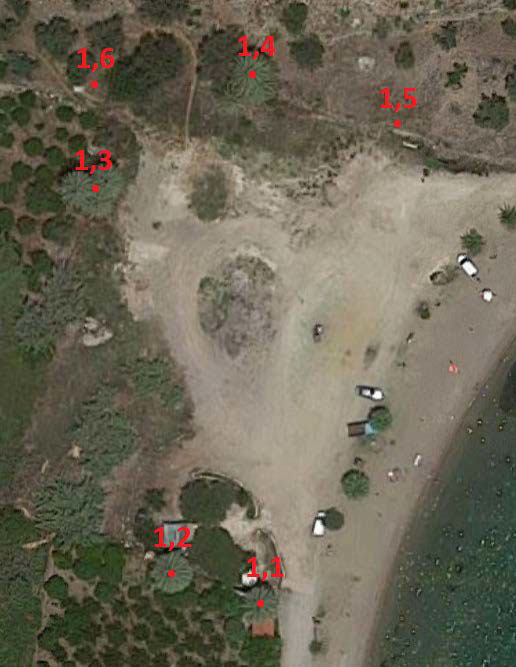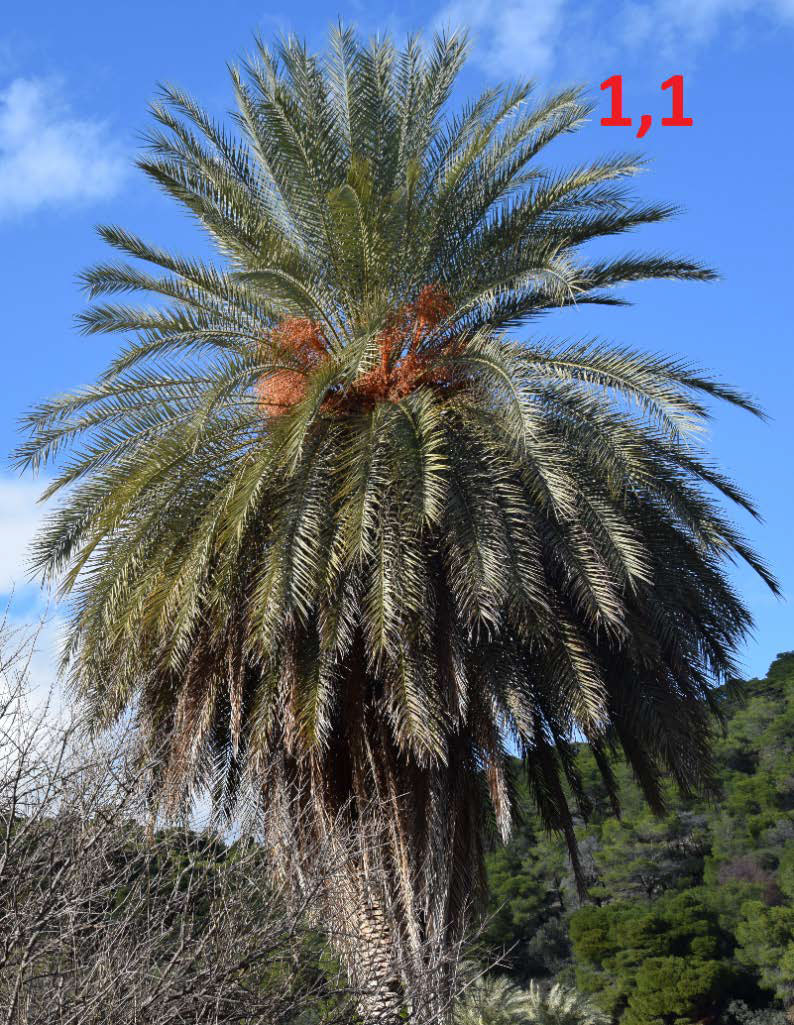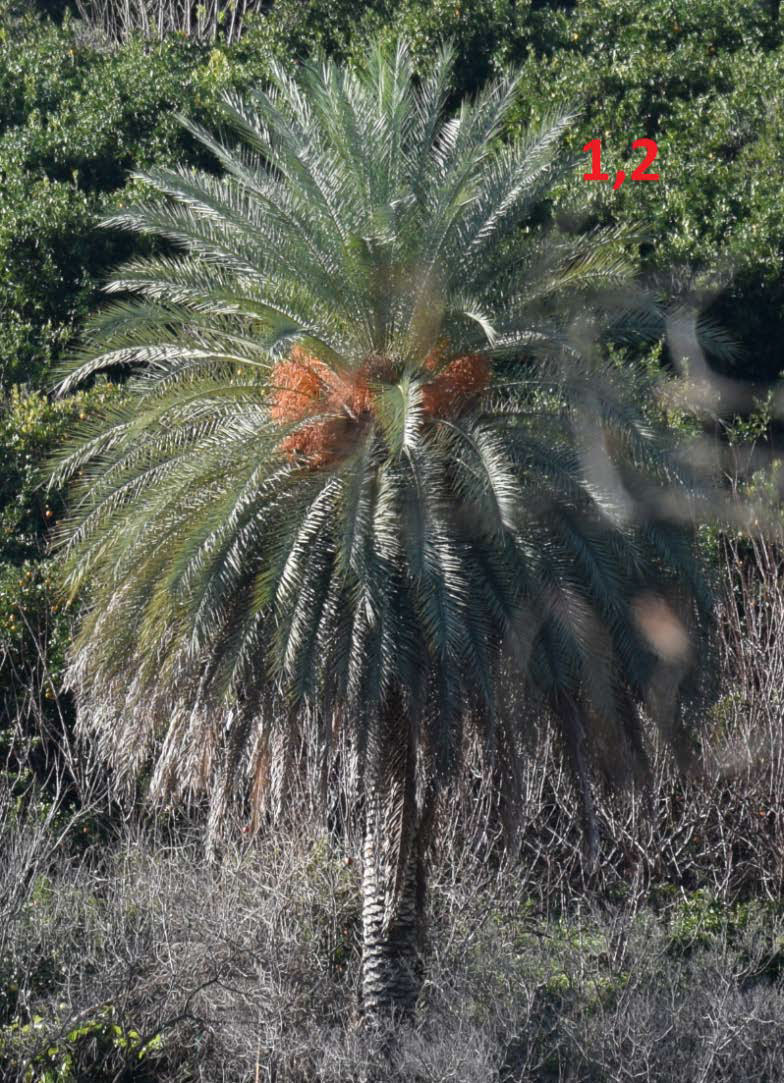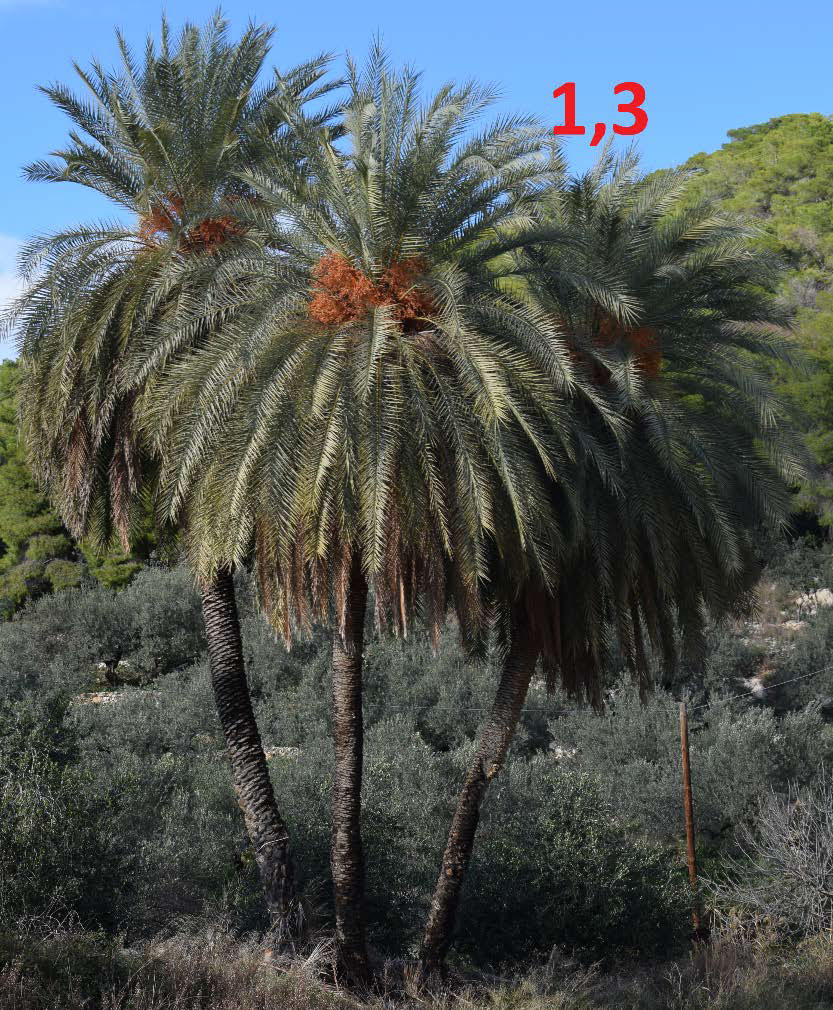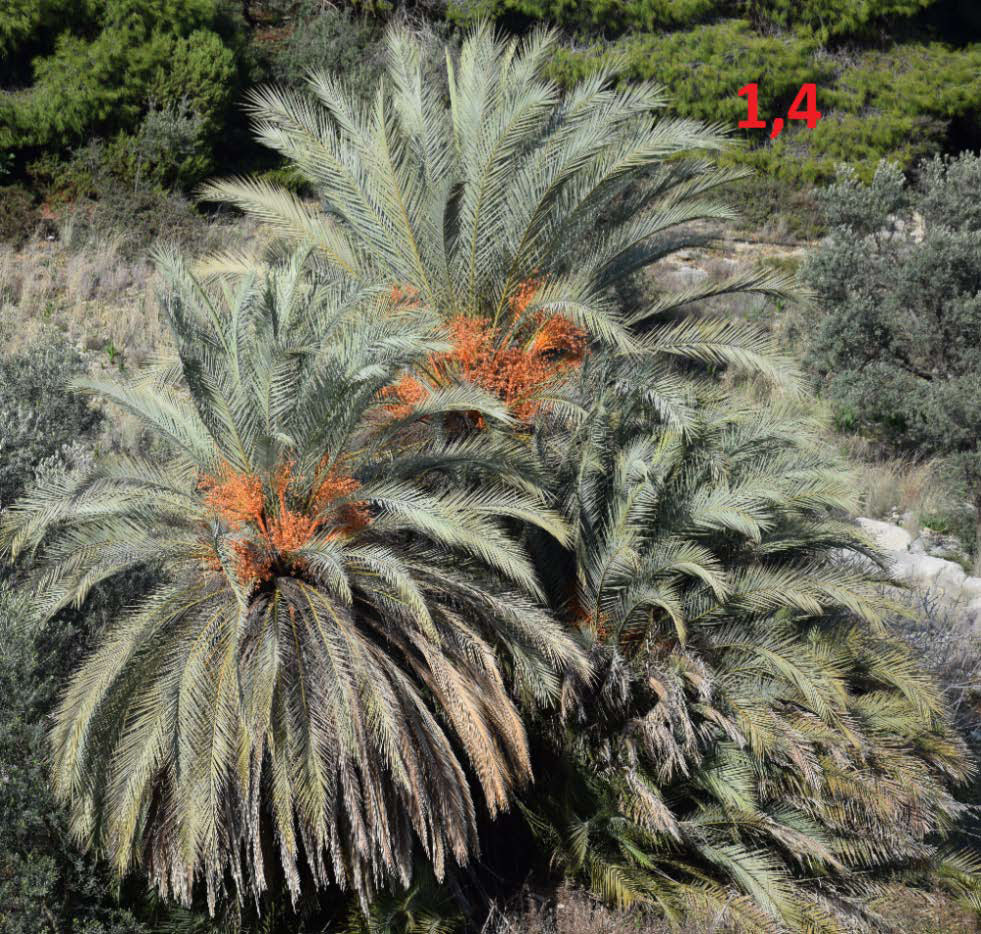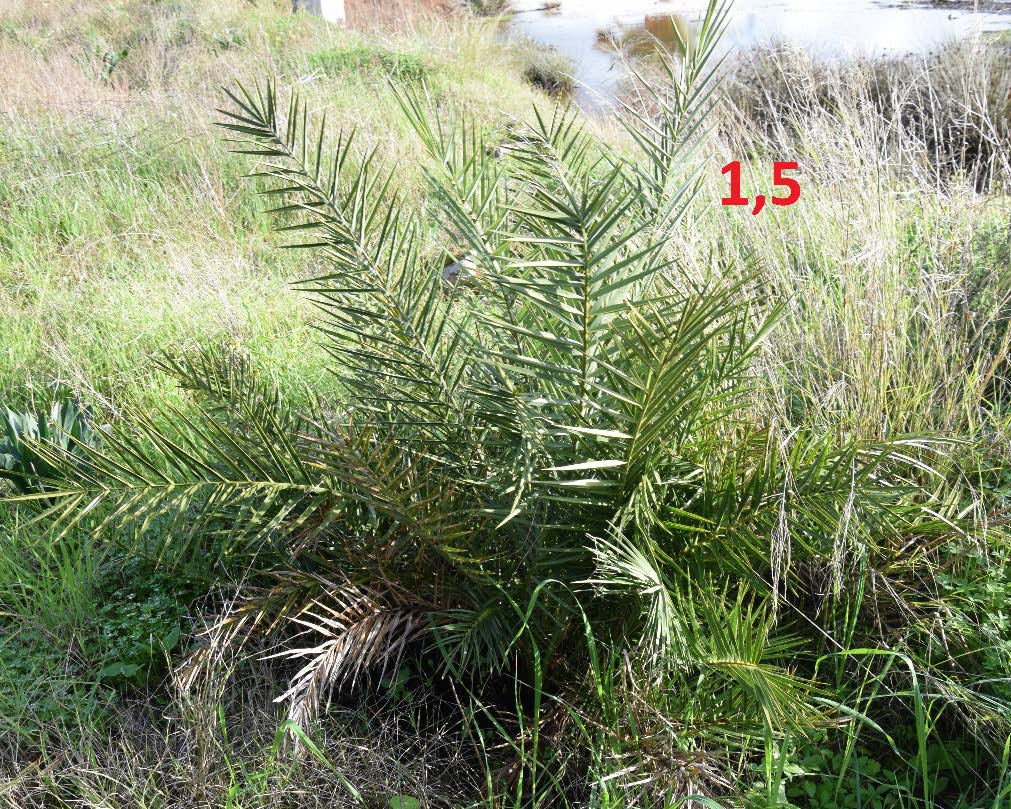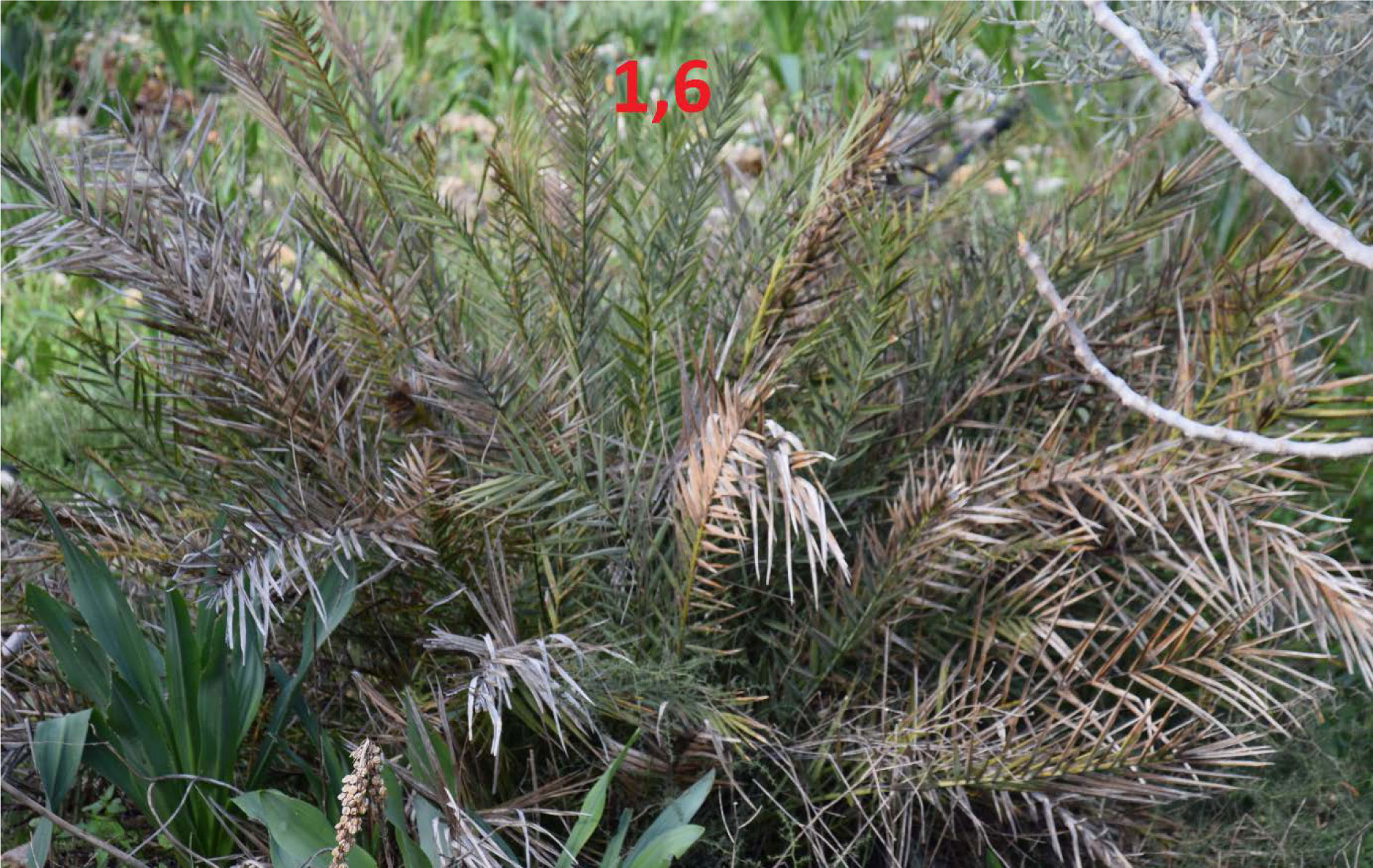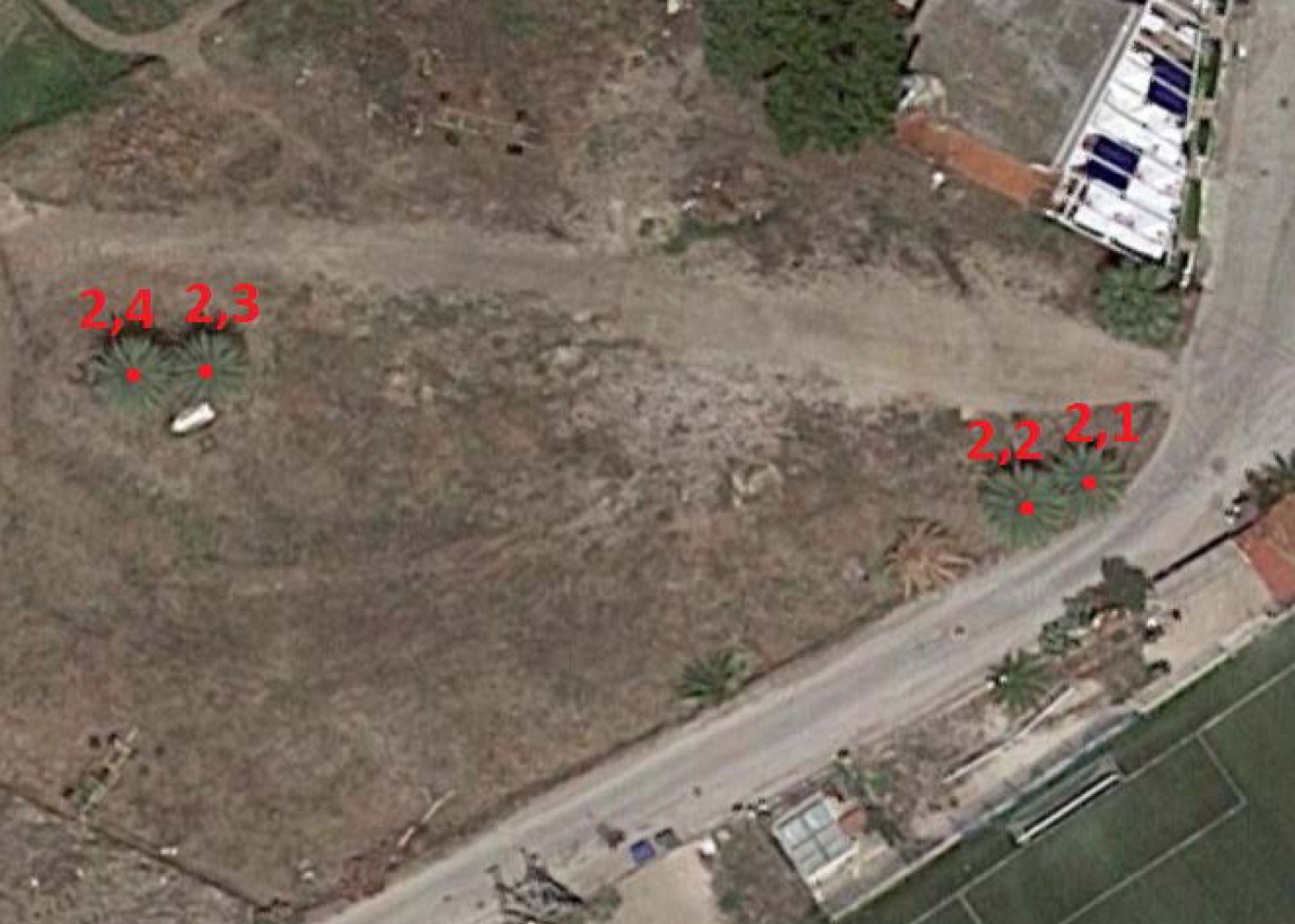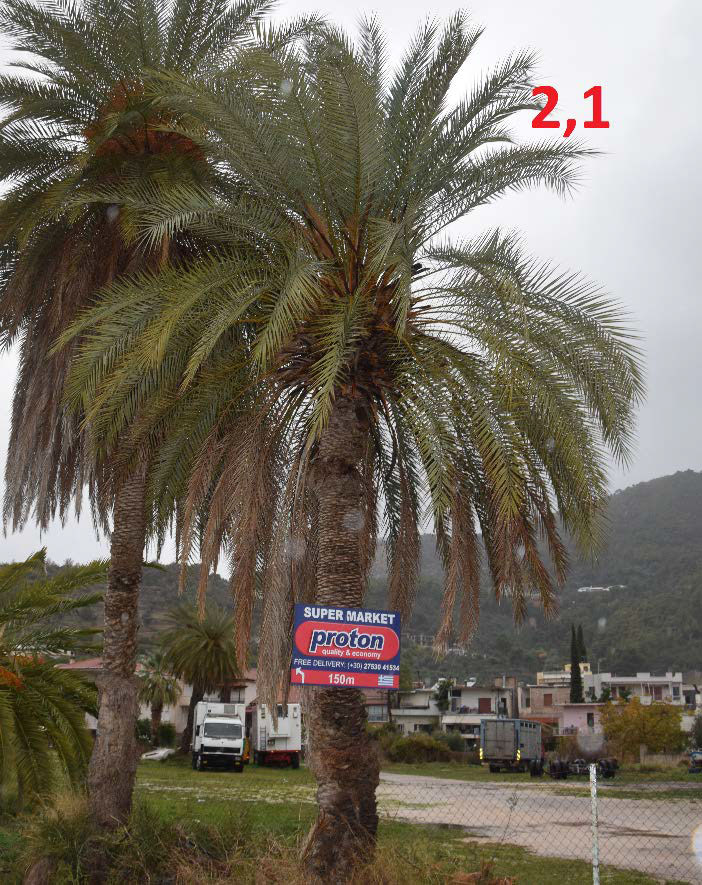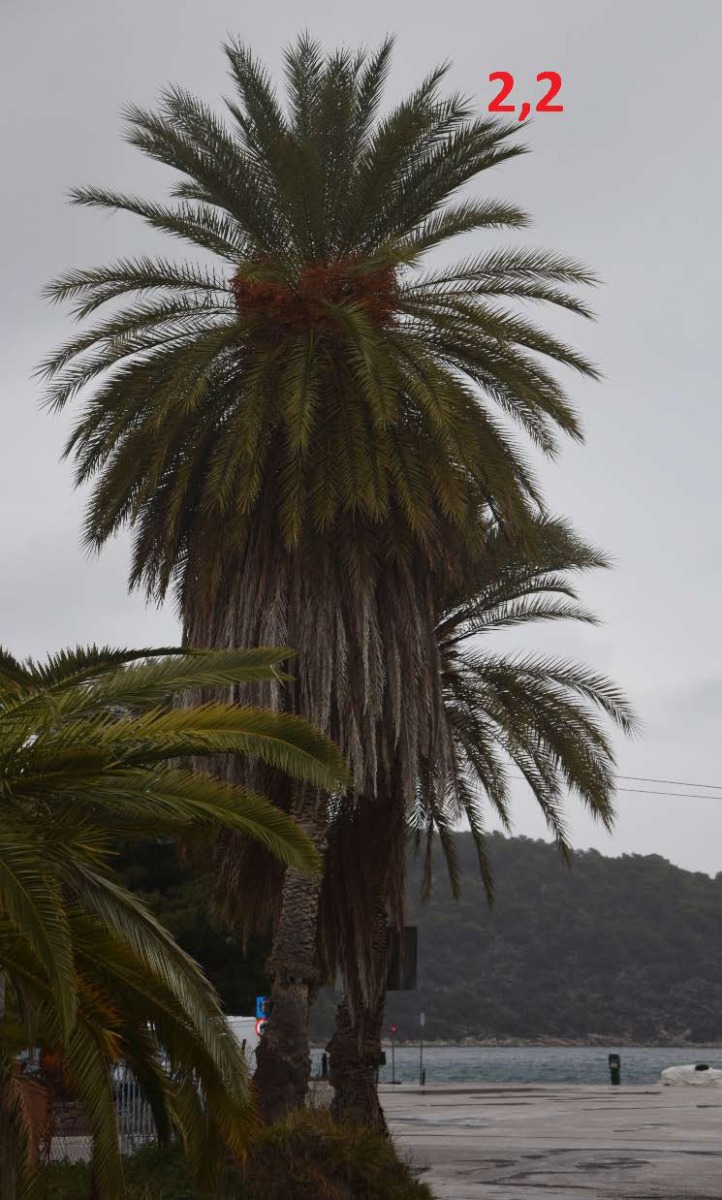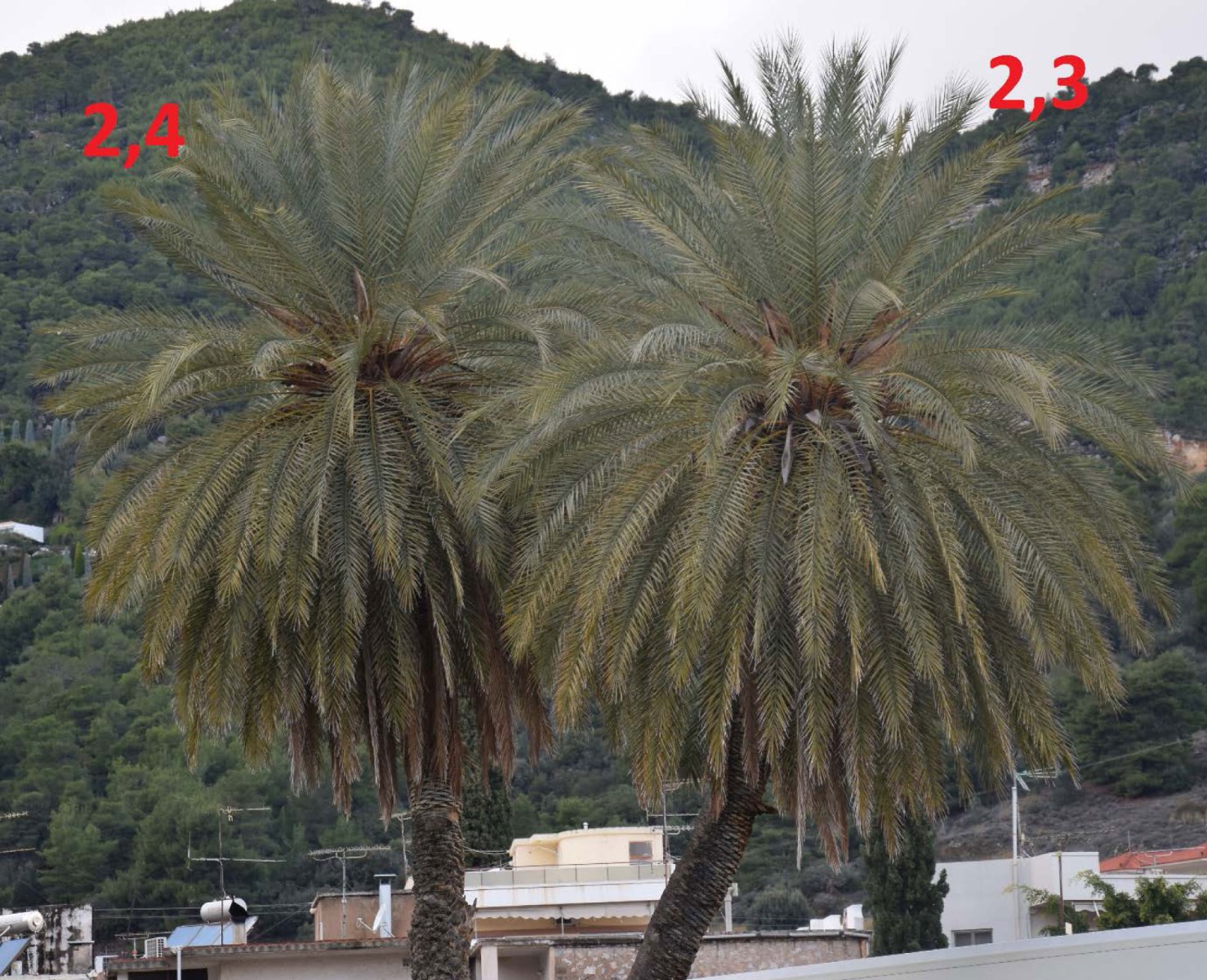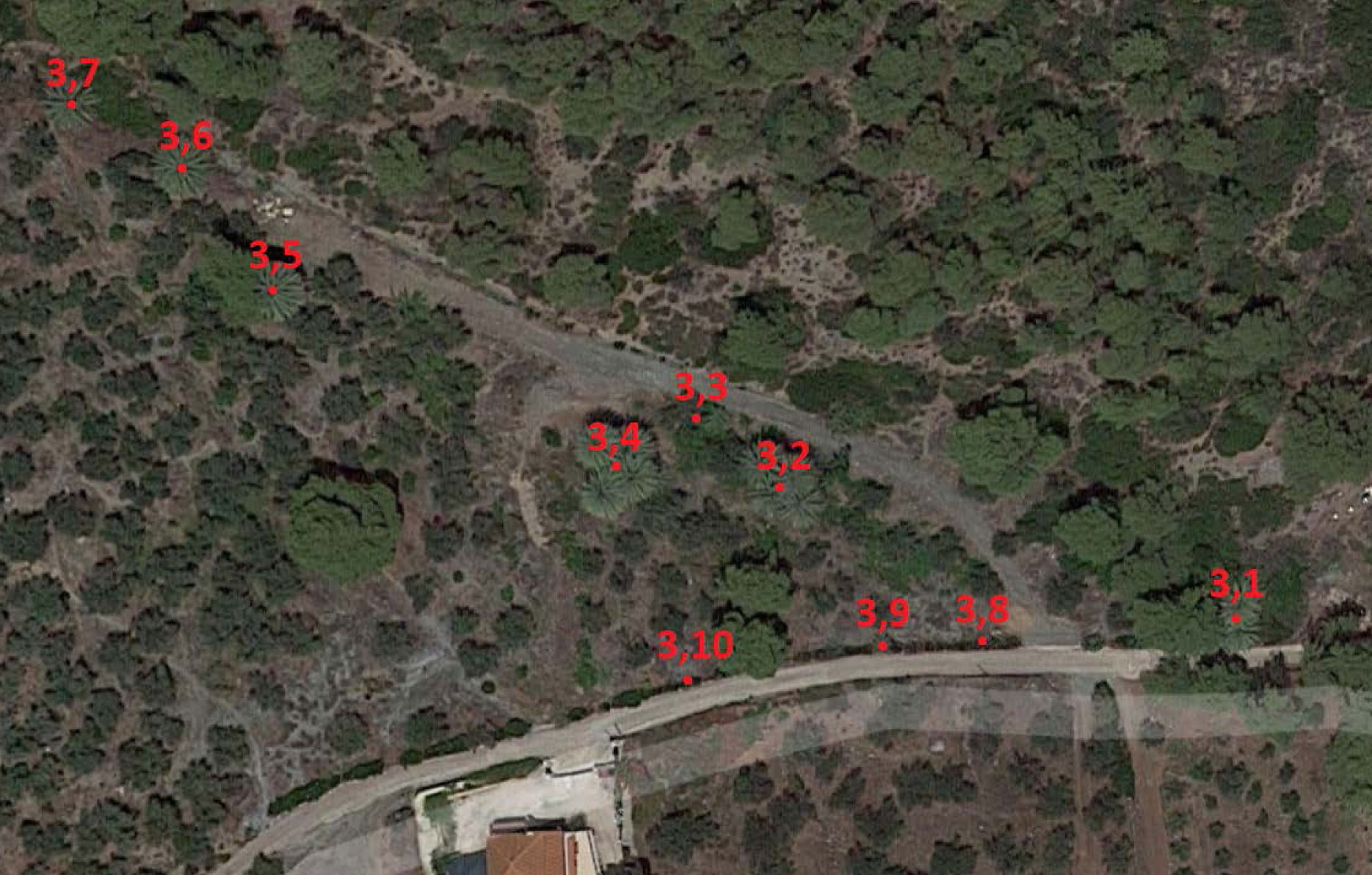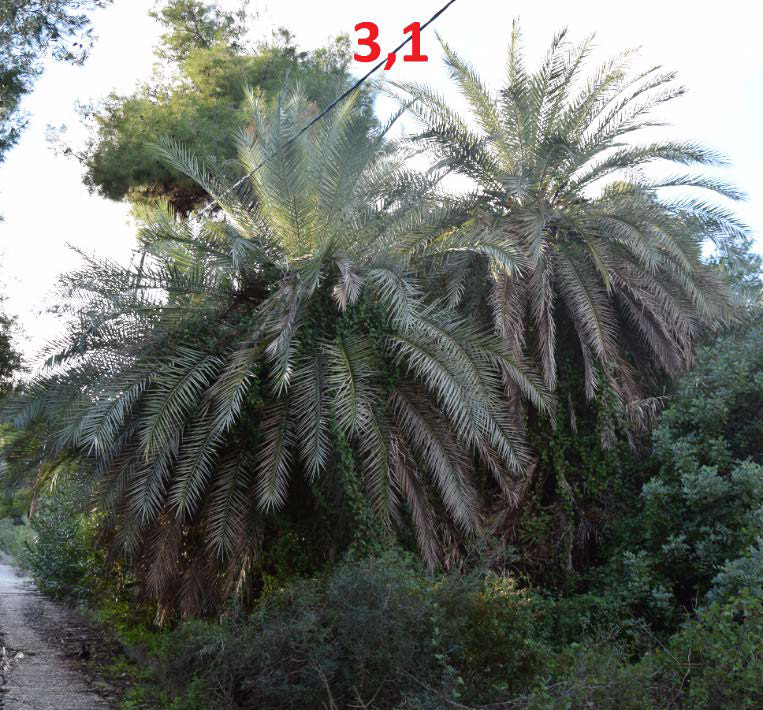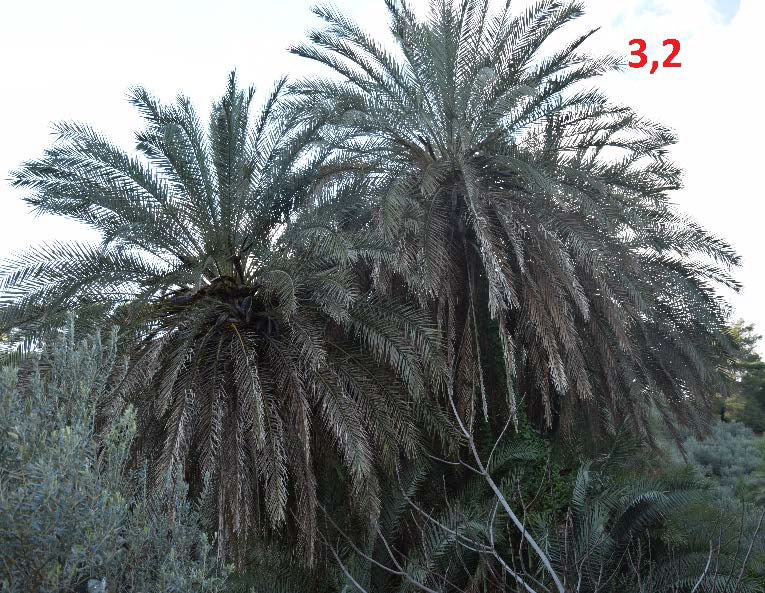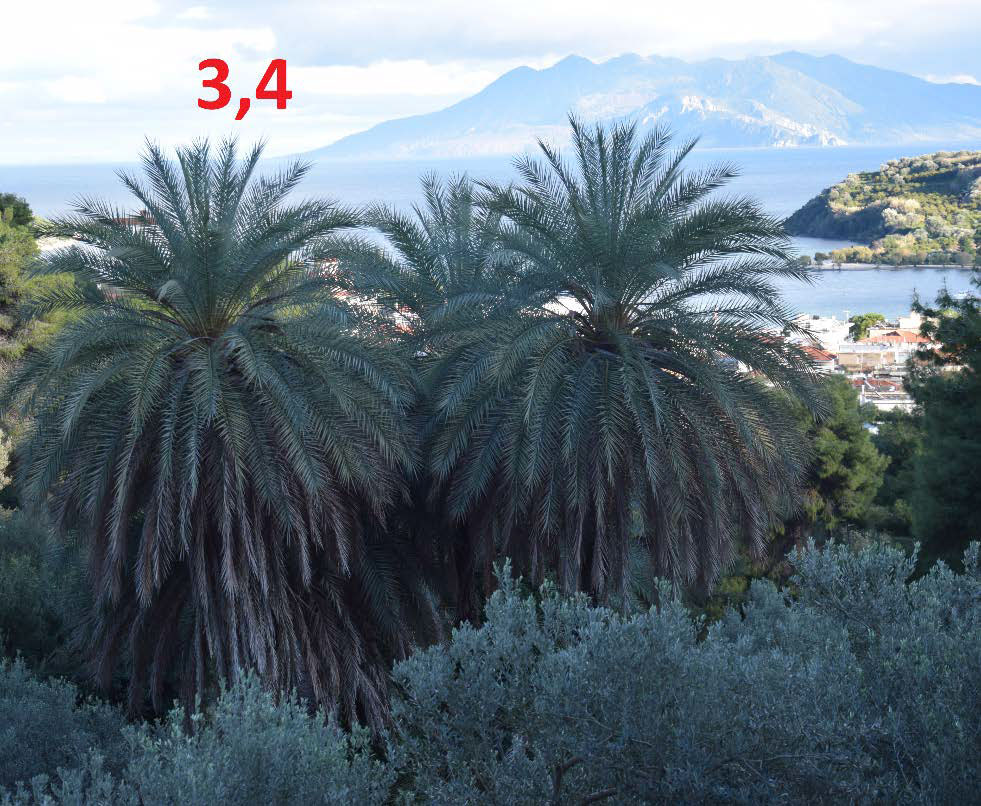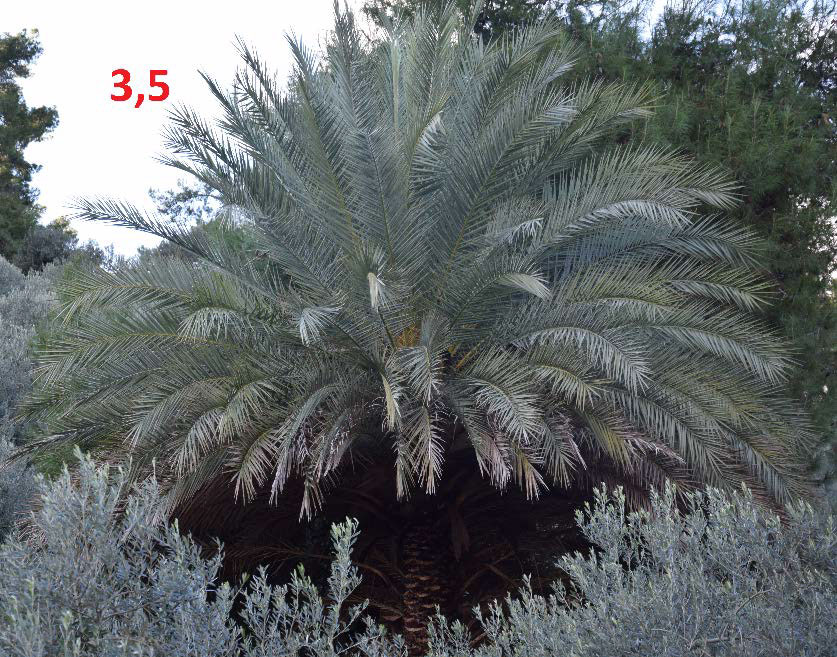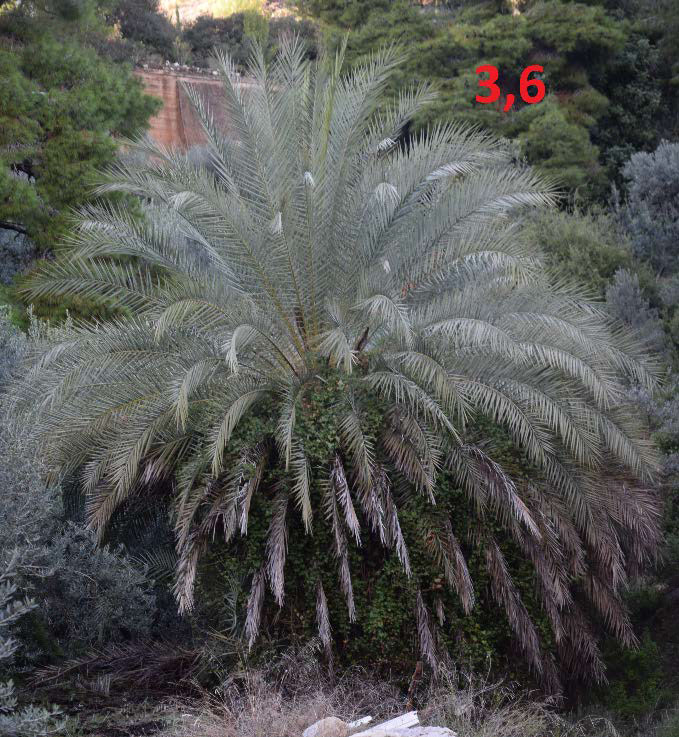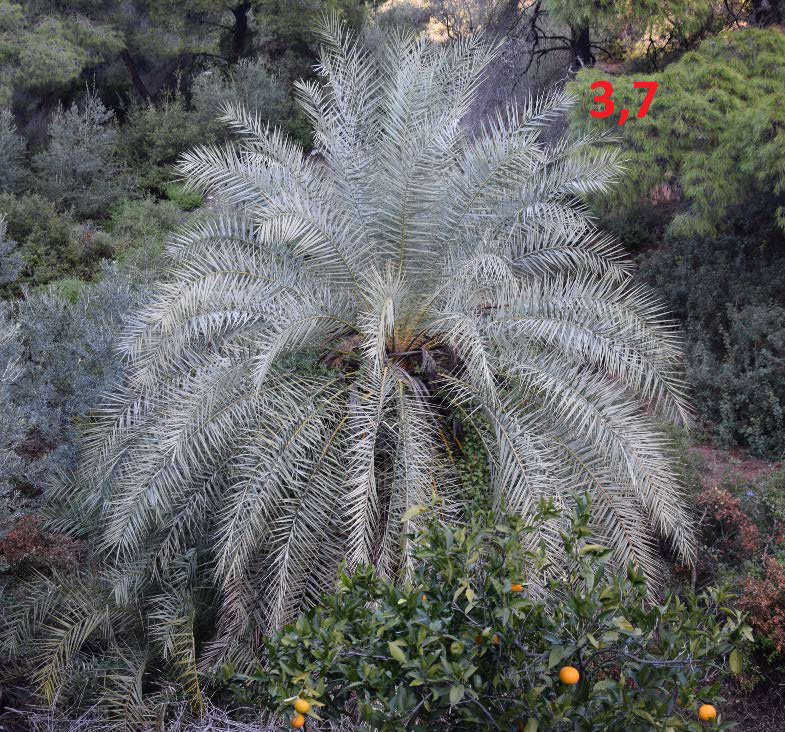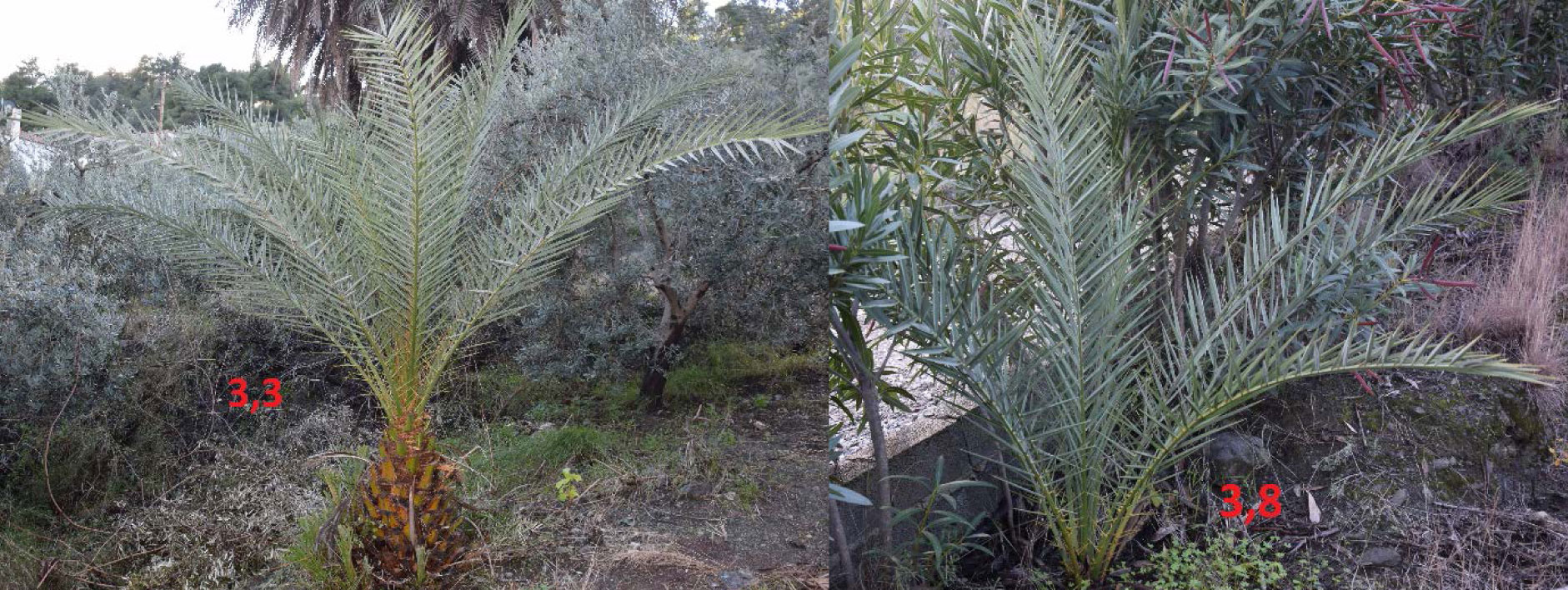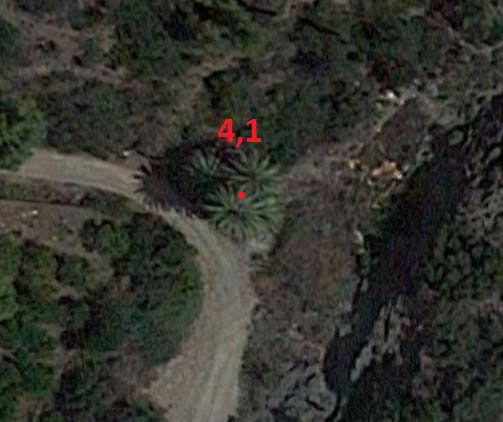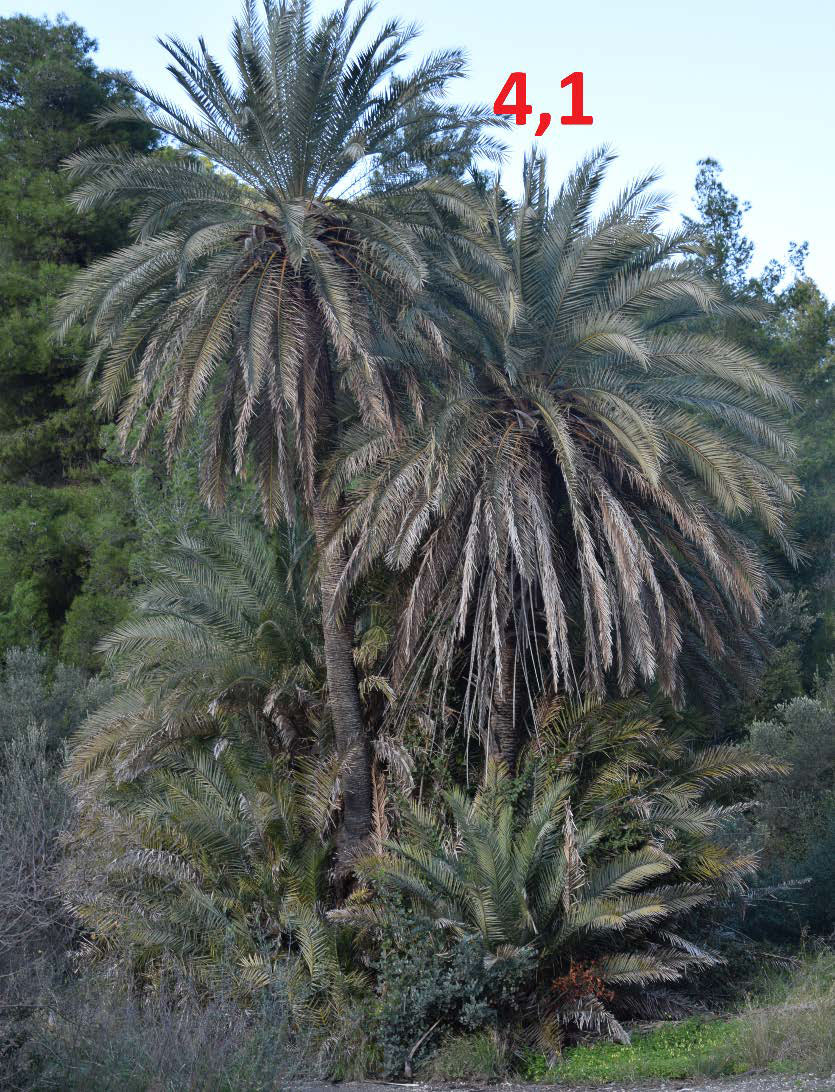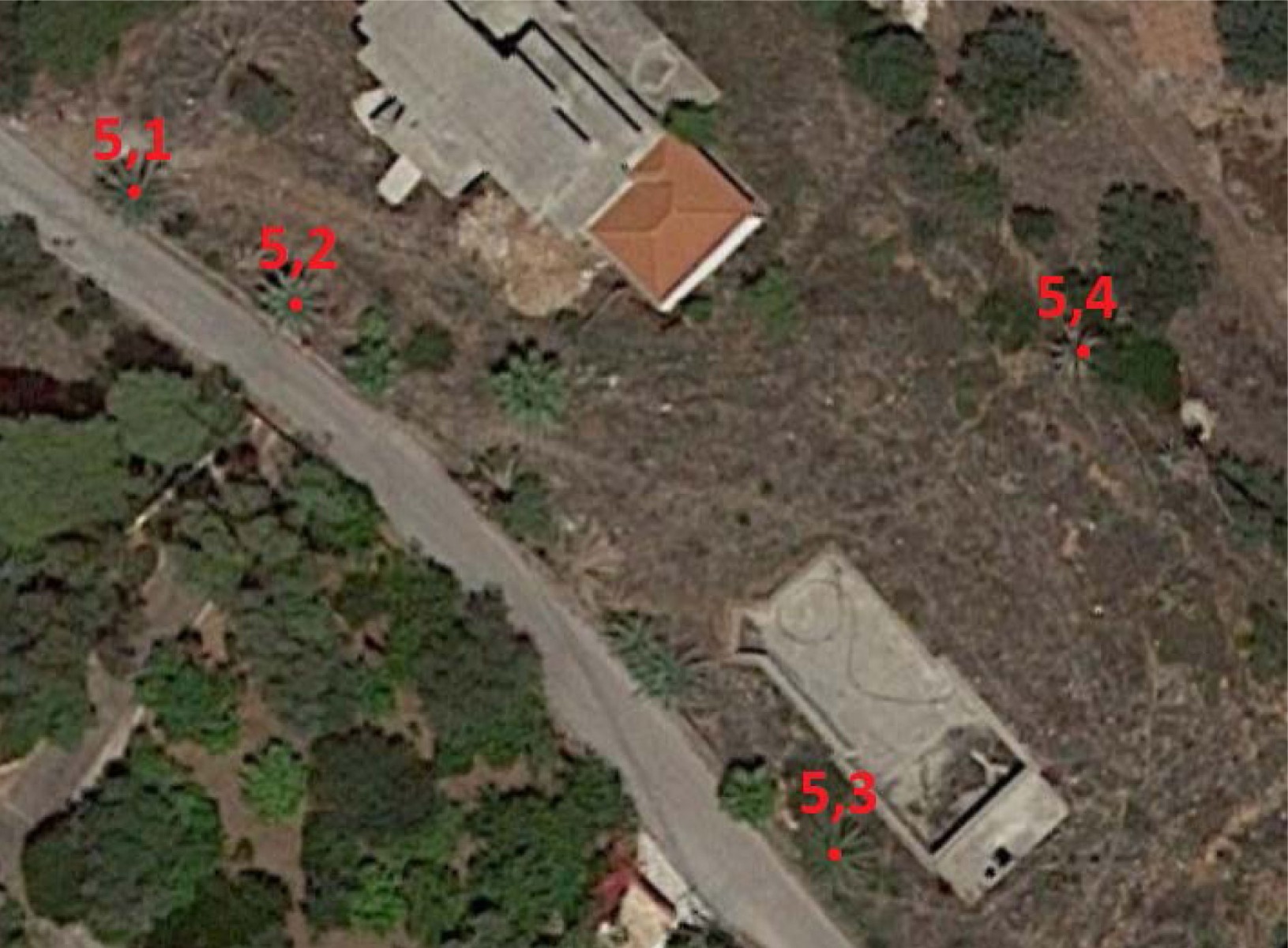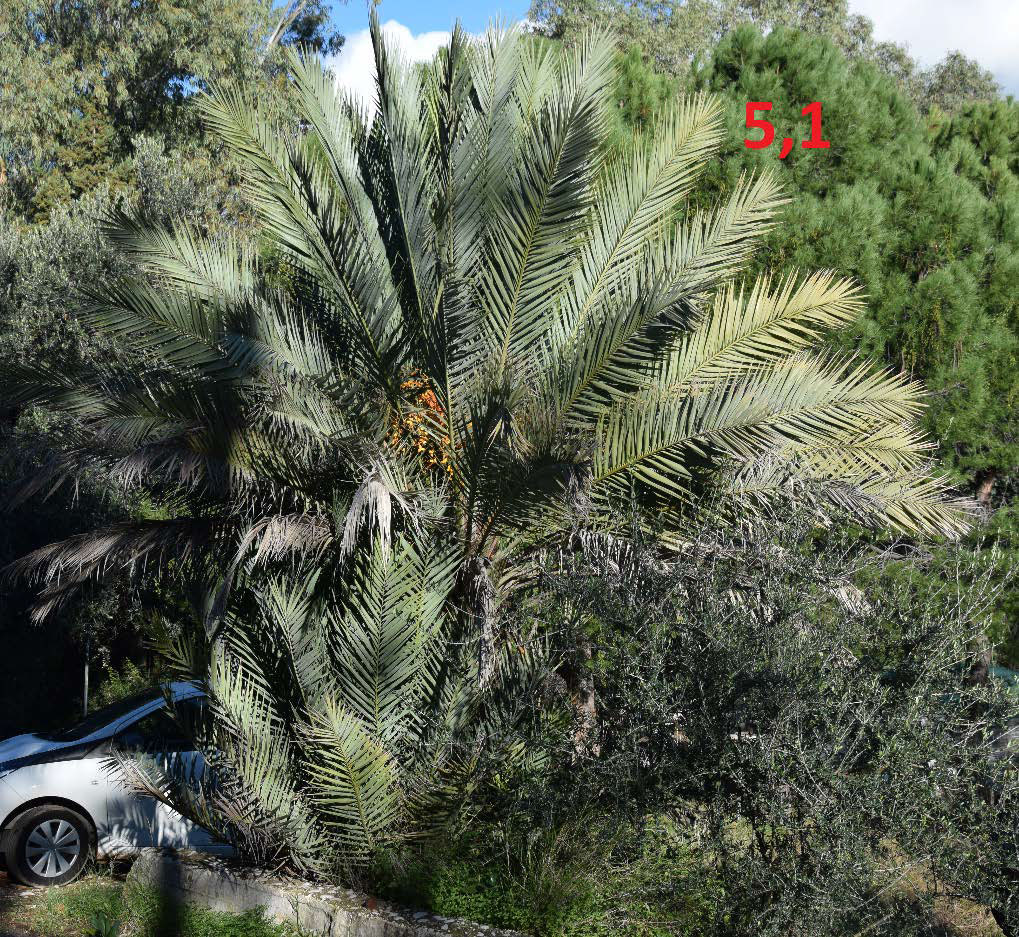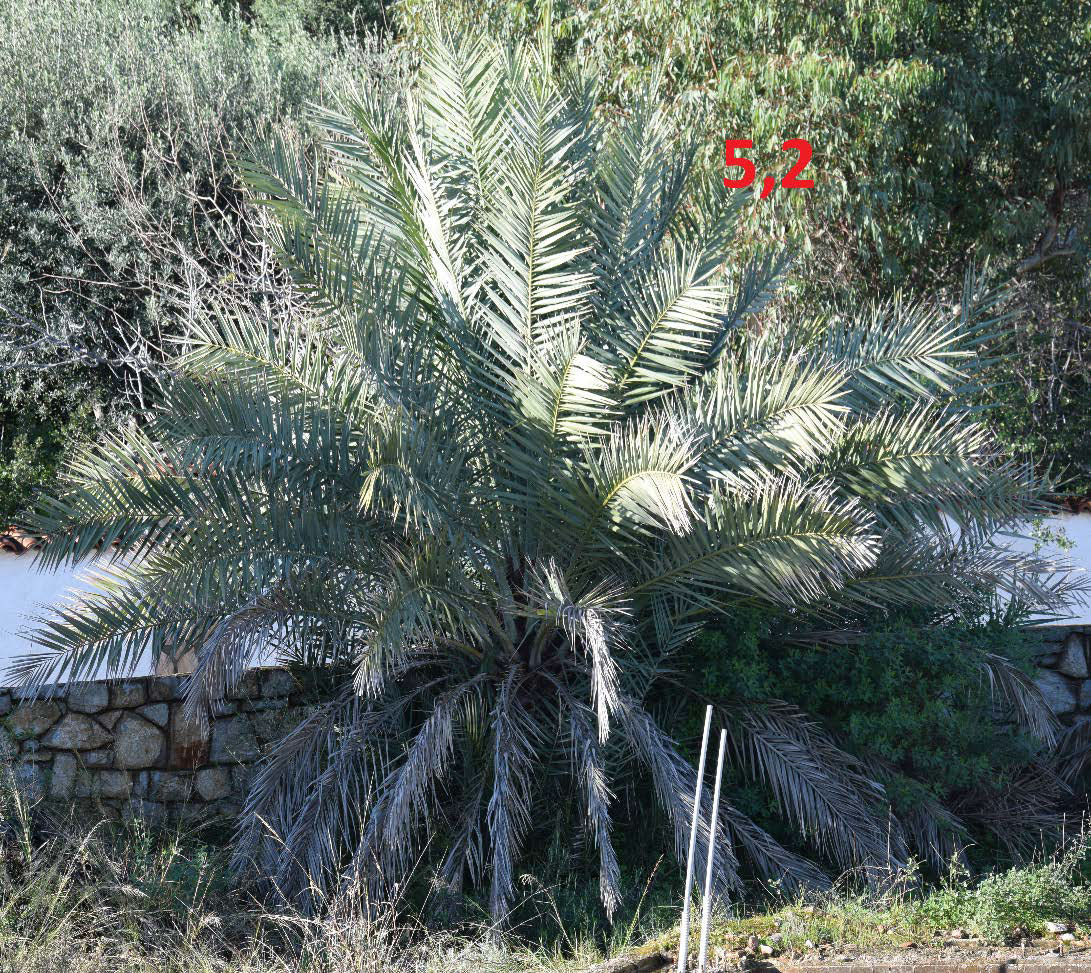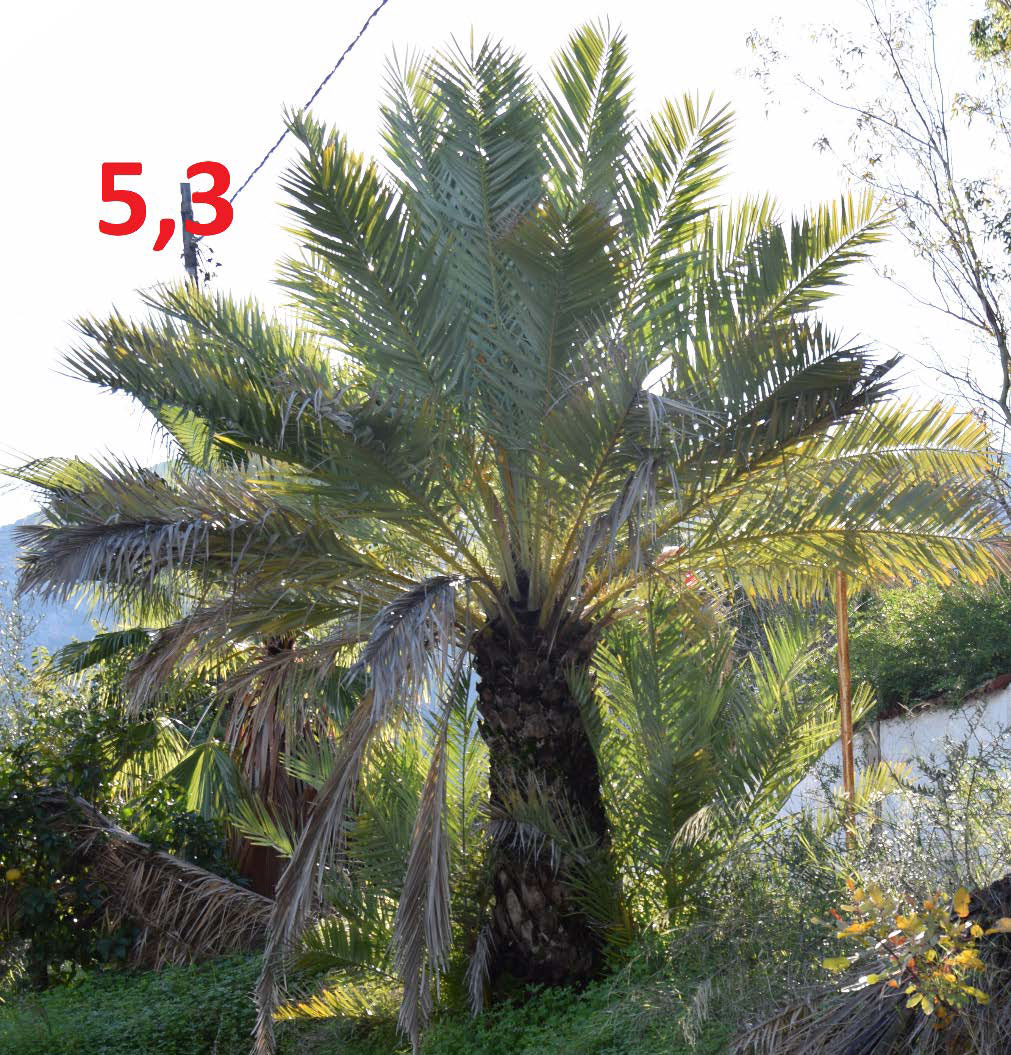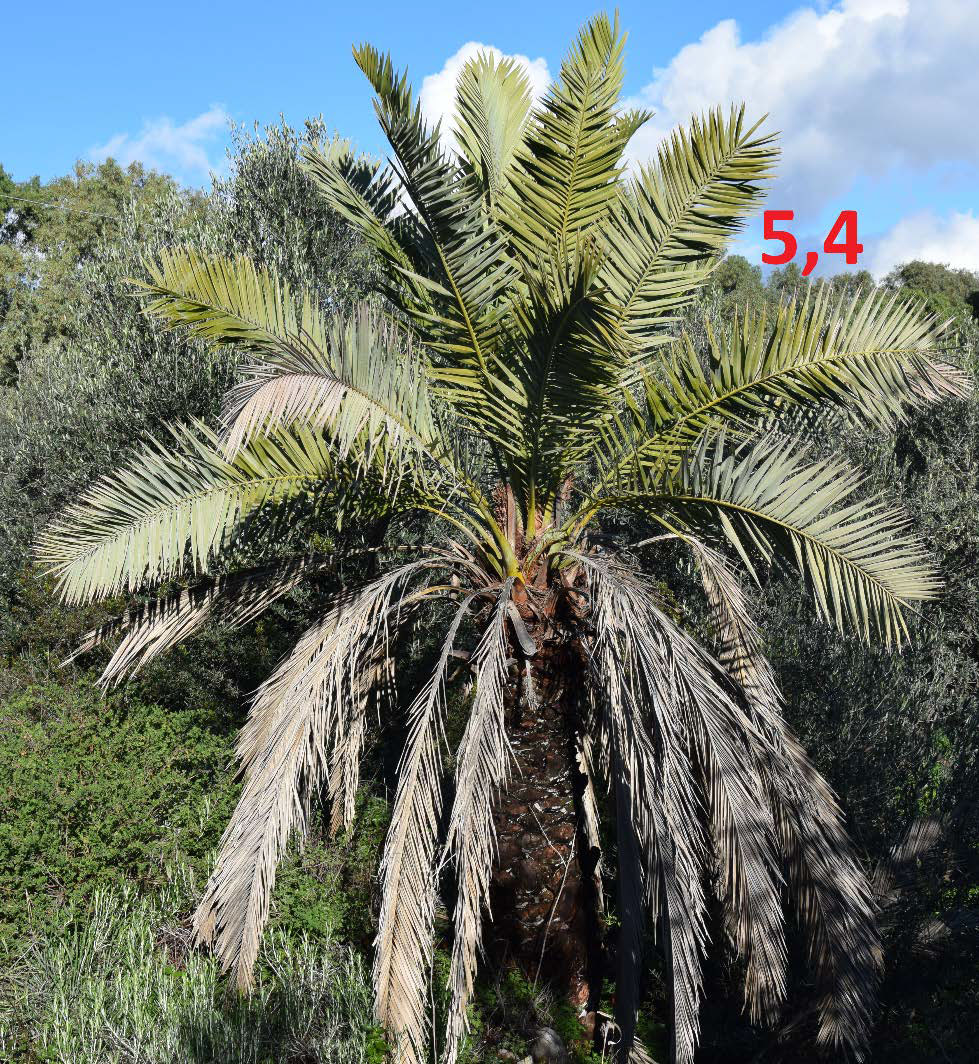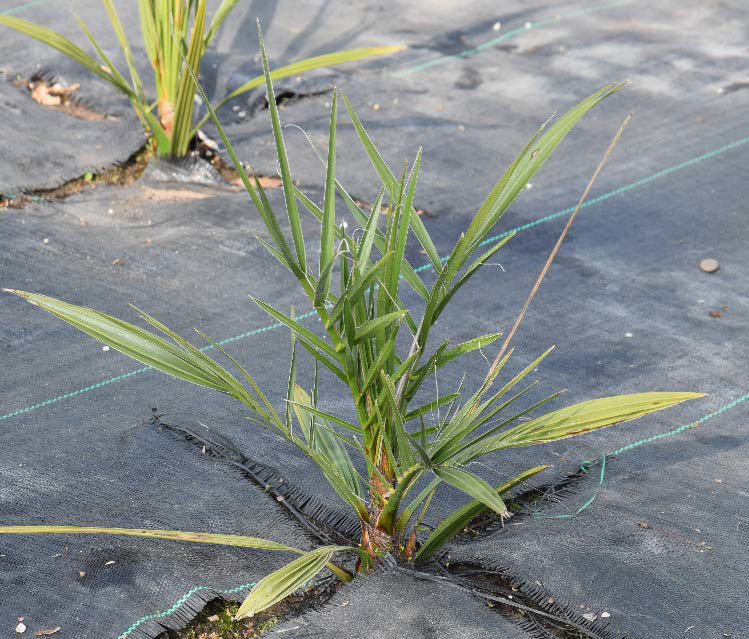Introduction
Phoenix theophrasti var. Epidaurus was first identified near the town Palea Epidavros on Peloponnesos, Greece by Thymakis (2009) and Greek palm enthusiasts and members of the Greek palm society. Since then detailed descriptions, measurements and localities of the Palea Epidavros palms were analysed and published in 2017 (Doedens, 2017). Conclusions of the previous study were that the morphology of the palms of Palea Epidavros differs from populations found on Crete and Turkey on multiple vegetative as well as generative plant parts. Furthermore it was found that the palms are endangered with extinction due to multiple threats.
Phoenix theophrasti was first described in 1967 from the now famous grove in Vai, Crete (Greuter, 1967). Since then ten coastal populations of Phoenix theophrasti have been identified growing in Crete on moist valley floors, stream banks and on coastal rocks and cliffs. Natural populations of Phoenix theophrasti are also known from four localities in Turkey. However, the population at Gölköy near Bödrum seems to have significant morphological differences in having a longer inflorescence peduncle, compared to the other populations on Crete and Turkey (Boydak et al., 1995). The International Union for Conservation of Nature (IUCN) classifies Phoenix theophrasti as "near-threatened", which indicates that there is no immediate cause for concern but that it could be threatened with extinction in the near future. Flowers JM et al, 2019 found that as much as 18% of North African date palms genome can be traced back to Phoenix theophrasti.
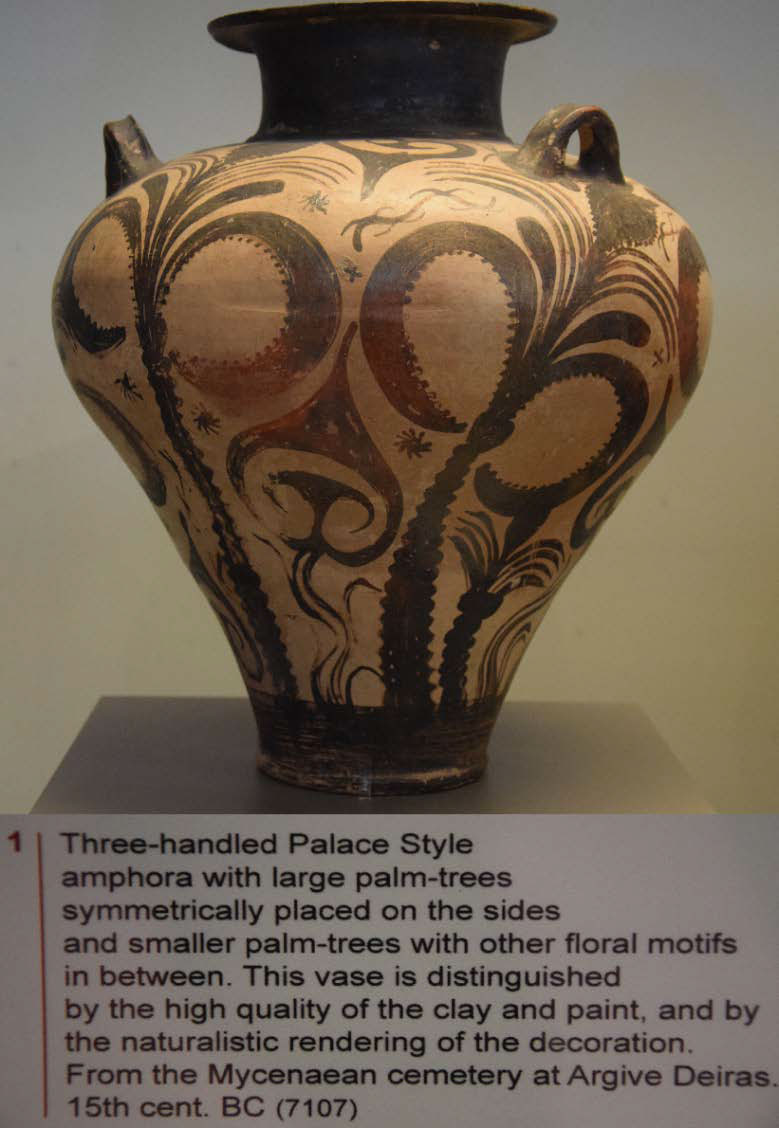
Figure 1: Ancient pottery decorated with clustering Phoenix palms. From the National Archaeological Museum in Athens
Palea Epidavros (also called Palaia Epidavros, Palea Epidaurus, Palaia Epidaurus, Ancient Epidavros or Archaia Epidaurus) was a city in the large kingdom of Epidavros that dates back as far as the Mycenean period (1600-1450 BC). Now Palea Epidavros is a small fishing and tourist village with around 1600 inhabitants (2011). It is likely that the Phoenix theophrasti palms of Epidavros are remnants of a much larger ancient palm forest. It is known from archaeology that Phoenix palms were common in the Argolis region. Ancient pottery decorated with figures of clustering date palms found in the region contributes to the idea that Phoenix palms were much more common in this region in ancient times (Figure 1). This gives the palms of Epidavros besides the unique genotype also great historical value. Therefore it is crucial to start conservation efforts to protect this living archaeology and ancient Greek heritage.
Description Phoenix theophrasti var. Epidaurus
Clustering, heavily armed palm, TRUNK. to 8m high, diameter 39cm, with persistent old leaves underneath the crown, trunk covered with densely packed diamond-shaped leaf bases 20-23cm wide 3.5-5cm high, usually with a large root boss 1-1.20m high. LEAVES. silvery blue-green, slightly arching, 80-130 in the crown, sheath 43-50 x 20cm, petiole 60-70cm, rachis 2.80-3.20m, orange to yellow spines length near petiole 4cm to 37.5cm near leaflets, leaflets reduplicate 97 on each side of the rachis, very stiff with a sharp tip, irregularly arranged in groups of 2 near petiole to 3 to the leaf end, leaflet length near petiole 35-42.5cm middle 35-39cm near leaf end 30cm width 1.5cm. STAMINATE INFLORESCENCE. yellow to white, peduncular bracts 1-1.20m with 1 split, peduncle 41-49cm, divided into 1 order, rachis 44cm, rachilla 8.5-21cm. PISTILLATE INFLORESCENCE. orange, erect, peduncular bracts length 52cm splitting in two, peduncle 35-69cm, divided into 1 order, rachis 20-39cm,rachilla 14-62cm FRUIT. 1.9x 1 x 0.8cm. SEED. 1.6 x 0.8 x 0,7cm.
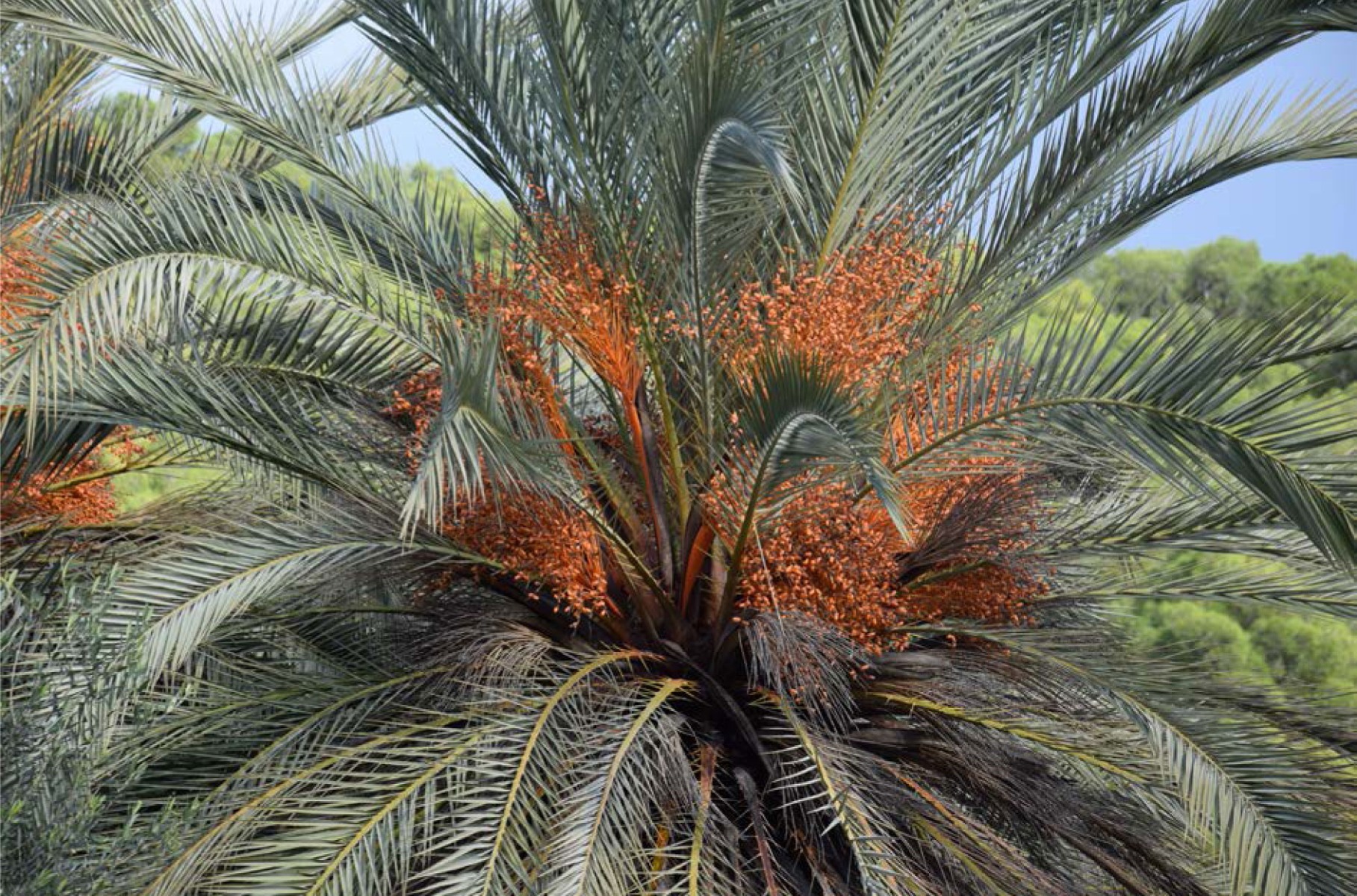
New finds and insights about seed dimorphism in the palms of Epidavros will be discussed in this follow-up study. Additionally, the distribution of the palms was mapped in detail with a separate description of each individual palm. Furthermore, the most important threats will be assessed with a focus on conservation strategies for the palms of Palea Epidavros.
Seed dimorphism in Phoenix theophrasti var. Epidaurus
It was observed that occasionally there was another type of seed laying on the ground underneath the Phoenix theophrasti var. Epidaurus palms at both subpopulation 1 and 2. The shape of these seeds are divergent to the regular seed type, it does not have the typical triangular shape but rather look similar to the oval shaped seeds of Phoenix canariensis (Figure 2). It was suggested that birds take the fruits of surrounding Phoenix canariensis and eat them in the highest tree, thus the seeds fall and ends up on the ground under the Phoenix theophrasti var. Epidaurus palms. However, evidence has now been found that a divergent seed type is actually produced by the Phoenix theophrasti var. Epidaurus palms themselves. Ripe seed clusters were sampled directly at the crown at population 2 and the divergent seed type was present in these seed samples, which were still attached to the inflorescence. The divergent seed type seems to occur at the ratio of 1 divergent to 205 regular typed seeds at subpopulation 2. The divergent seed type seems to occur more often at subpopulation 1, based on seeds found on the ground but it cannot be ruled out that some of these seeds are Phoenix canariensis. The average weight of the divergent seeds is substantially higher (0,89g) then regular seeds (0,59g).
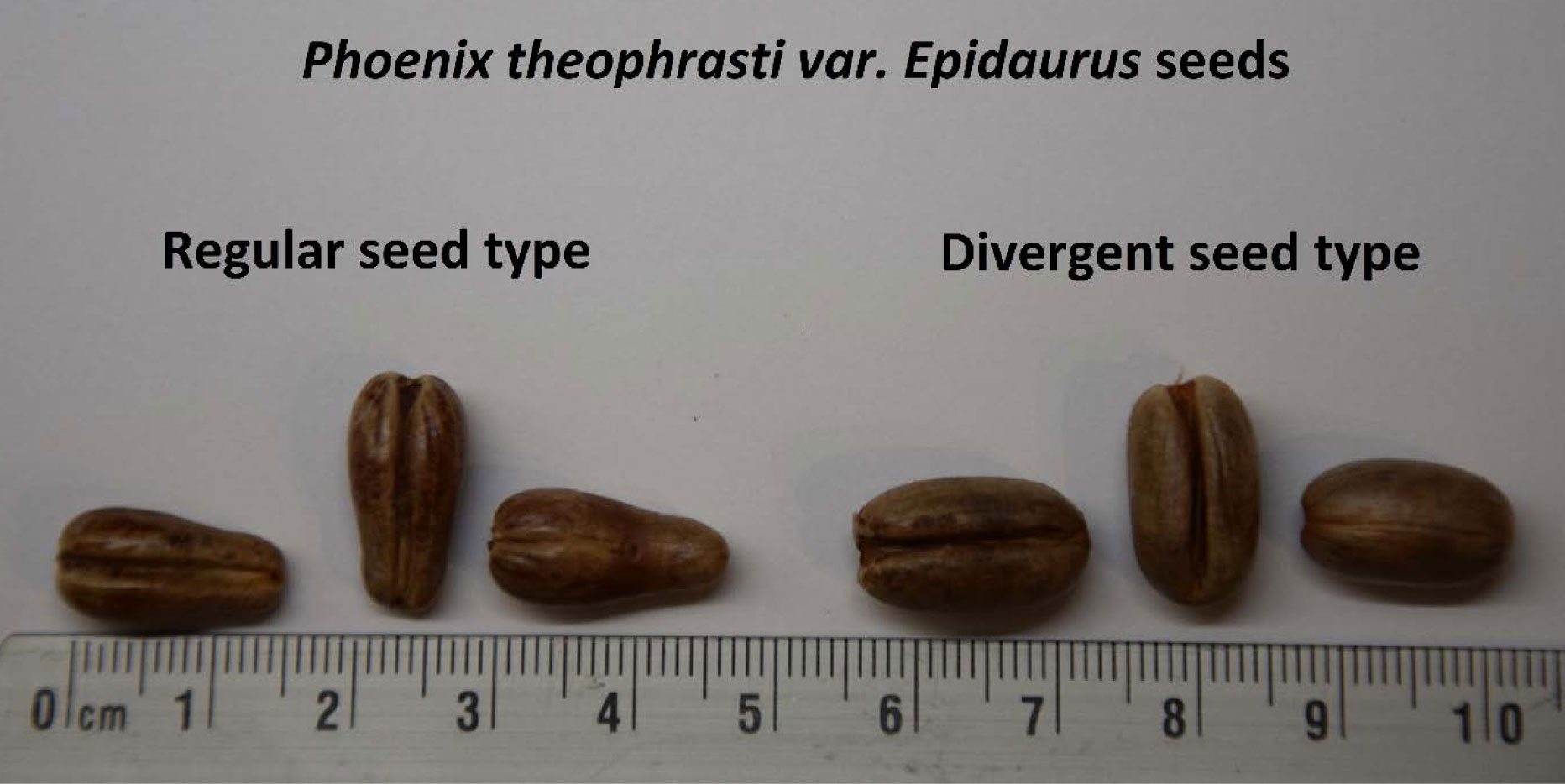
Figure 2: Comparison between the regular typical triangular shaped seeds and the divergent seed type.
Seed dimorphism (also termed seed polymorphism or seed heteromorphism) is the evolutionary strategy where a plant is capable of producing two or more distinct types of seed, which may differ in morphology, ripening, dormancy, seed size, dispersal, or germination time (Hughes, et al 2018). Seed dimorphism has been shown to be an effective strategy to cope with unpredictable environments. It can be beneficial for plants to “hedge their bets”, when for example a drought kills all recently germinated seedlings but other seeds remain dormant but alive in the soil. It is likely that Phoenix theophrasti var. Epidaurus has evolved a similar bet hedging strategy to maximize the fitness of the seeds. First results indicate that germination time of the divergent seed type is longer (5-7 weeks, day 33±2°C night 18±2°C) compared to the regular seed type from the same palm (2-3 weeks) under the same conditions. Growth of the seedlings will be monitored and compared with the regular seeds in the coming years.
Distribution of the Phoenix theophrasti var. Epidaurus palms
Distribution (localities) of the subpopulations
The population of just 25 Phoenix theophrasti var. Epidaurus palms in total is distributed in 5 subpopulations in and around the town of Palea Epidavros, Peloponnesos, Greece. The subpopulations 1, 3 and 4 are located close to the hillsides, this contributes to the idea that there used to be a much larger palm forest in the Palea Epidavros delta. It is likely that the palm forest had to make way for olive and citrus cultivation and buildings and that the remnants managed to survive near the hills where it was too steep for agricultural practises or buildings. The Palea Epidavros delta is eastern orientated and sheltered by hills on the north, west and south side. The habitats of all localities are mostly similar valleys floors which have moist soil conditions year round, with flowing fresh water right at the base of the palms at subpopulation 1, 3 and 4 during winter.
Subpopulation 1
Subpopulation 1 is located on Vagionia beach on the north side of the village of Palea Epidavros. The name Vagionia originates from the ancient name ‘Vayonia’ (Βαγιωνιά), which includes ‘Vaios’ (Βάιο) which translates to palm leaf. It is thought that this subpopulation originates from ancient times. The palms in this subpopulation are located just several meters away from the sea. The bay is sheltered by hills to the north and the west. Because of the eastern orientation of the beach the palms receive full morning sun. The soil conditions are moist year round with flowing freshwater between palm 3 and 4 streaming into the sea during winter. This subpopulation consists of six palms ranging from young juveniles to old clumps with multiple trunks. Surprisingly, all palms at subpopulation 1 appear to be female.
Palm 1,2 is a large female, single trunked palm located next to palm 1,1 on private property. Most fruit on this palm is parthenocarp producing just few viable seeds. It is slightly larger and more robust compared to palm 1,1 with a more dense crown.
Palm 1,3 is a large female clump with three nearly similar sized trunks. It has a large root boss of 120cm above ground level. It is located at the centre of Vagionia beach at the wettest part. The soil that gets completely soaked during winter with running water just meters away from the root boss. All fruits of this palm are parthenocarp producing no viable seeds. Because of the large root boss it is likely that this is the oldest palm at subpopulation 1, and some of the other palms could originate from this palm.
Palm 1,4 is slightly different compared to the other palms. It is a clump with small to moderate sized trunks. It is located on the northern side of subpopulation 1 on one of the wettest parts of the beach with running fresh water just meters away from the trunks. It seems to have a more compact growth habit with lots of shoots. Also the leaves seem to have a bit more curve. These differences are possibly the result of the environment or genetic variation. Unfortunately all fruits of this palm are parthenocarp producing no viable seeds.
Palm 1,5 is a small juvenile which grows in moist soil. This palm was slightly larger before it completely burned to the ground in 2016. It is likely that the fire was used as a ‘treatment’ for an infection of the red palm weevil (Rhynchophorus ferrugineus). This individual showed that the palms of Epidavros can survive fires just like the Phoenix theophrasti survived the 2010 wildfire at Preveli, Crete.
Palm 1,6 is a small clustering juvenile which grows in moist soil close to the riverbed. It is located north east side on private property behind a fence.
Subpopulation 2
Subpopulation 2 is located just south of the village centre near the harbour. It used to be near the sea until the harbour was expanded in the 1980’s. This subpopulation is located on an uncultivated field on private property next to the local football field. The field is used for storage of boats and trucks during winter. This field is a bit drier compared to the wet riverbeds at subpopulation 1, 3 and 4. Since the palms are growing on an open field they receive full sun year round and are not sheltered from the sea wind. This subpopulation is unique because it has both male and female palms and may therefore be the only true to type seed producing tree (2,2).
Palm 2,1 is a moderate sized male palm. It is located on the eastern part of the field near the entrance. It is possible that this palm is the offspring of palm 2,2 or at least closely related which is standing just several meters next to it. Also, it is likely that this palm is mainly responsible for the pollination of palm 2,2.
Palm 2,2 is a large female palm. It is located on the eastern side of subpopulation 2. It is located behind a fence on private property. This may be the only true to type seed producing Phoenix theophrasti var. Epidaurus palm. It is most likely that it is pollinated by the male palm 2,1 which is standing just meters away. It is also possible that at least some of the flowers are pollinated by palm 2,3 and 2,4 which is standing a bit further away. Although the closest male Phoenix canariensis is about 80 meters away, it cannot be completely ruled out that there could be some interspecific hybridisation. However, the offspring does not show signs of heterosis but quite the opposite. Albinism, stunted growth and other sign contribute to the idea of inbreeding depression. Seed dimorphism was observed on this palm by having two distinct seed types.
Palm 2,3 and palm 2,4 are both large male palms located in the middle of an uncultivated field on private property. It is possible that both palms are connected to each other and it is actually a clump of two.
Subpopulation 3
Subpopulation 3 is located on a hill, west of the village of Palea Epidavros. The palms grow in a valley floor in moist soil with running water near the bases of the palms during winter. The valley is sheltered from the north and south side by the steep hills. Because of the hills this subpopulation receives less sun hours during winter compared to the other subpopulation. It is likely that this subpopulation has survived since ancient times because the valley with the steep hillsides are not suited for agricultural practices. Remarkably, all adult palms at this subpopulation appear to be male, thus lacking generative multiplication.
Palm 3,1 is a moderate sized male clump with two main trunks. It is the first palm that can be observed from the road. It is being overgrown by surrounding vegetation and climbing plants.
Palm 3,2 is a large male clump with four main trunks and many lateral shoots.
Palm 3,4 is a stunning large male clump with four main trunks and relatively few lateral shoots. It is the largest, and probably the oldest palm of this subpopulation.
Palm 3,5 is a single trunked medium sized male palm with some lateral shoots. It is located slightly off the road in the olive plantation. The old leaves appear to be pruned only on one side of the trunk.
Palm 3,6 is a relatively small single trunked male palm. It is being overgrown by climbing plants and other vegetation. It has only few lateral shoots.
Palm 3,7 is the highest growing palm of this subpopulation at the end of the valley. It is a relatively small male palm with few lateral shoots.
Palm 3,3, 3,8, 3,9, and 3,10 are small palms located near the roads. It is likely that they are vegetative cuttings from other palms in this subpopulation and therefore could be genetically identical. They are being pruned and lateral shoots have in some cases been removed.
Subpopulation 4
Subpopulation 4 is the most inland subpopulation west of the Village of Palea Epidavros on a side road from the main entrance road to the village. It consist of just one very old palm which is sheltered by the two mountainsides.
Palm 4,1 is located in near the corner in a dirt side road from the main entrance road. It is a large, old palm with four main trunks and many lateral shoots. It is possibly the oldest Phoenix threophrasti var. Epidaurus palm. It grows in a moist valley with running fresh water just near the base of the palm during winter.
Subpopulation 5
Subpopulation 5 is the southernmost of all subpopulations. It is located in the most southern part of the Palea Epidavros delta. Currently, it consists of just four palms, however there used to be at least seven, and some locals say there used to be even more at this site. Three of them died due to damage caused by the red palm weevil in 2018. However, it could be possible that some of these palms will sprout again from the base. All four palms are relatively young and it seems that at least three of the four remaining palms are planted because of their location next to the road.
Palm 5,1 is a relatively small and young palm with one main trunk and some lateral shoots. It is the first palm located next to the road just behind a wall. It is a female palm producing fruit, however all fruits of this palm are parthenocarp with no viable seeds.
Palm 5,2 is the second palm located next to the road. It is a young palm with few lateral shoots. It hasn’t produced any inflorescence yet.
Palm 5,3 is the last palm located next to the road. It is a small, young palm with a few lateral shoots. It is a female palm producing fruit, however all fruits of this palm are parthenocarp with no viable seeds.
Palm 5,4 is a small and relatively young palm. It is located further downhill on the side of a olive yard. It has one main trunk and no lateral growth at the base, however it does has some lateral shoots in the crown on two meters height. The black ash on the trunk indicate that it has been burned recently. Burning of Phoenix palms is known to been used as a treatment of the red palm weevil in the village of Palea Epidavros.
Threats and conservation of the ancient Phoenix theophrasti var. Epidaurus palms at Palea Epidavros, Greece
With just 25 Phoenix theophrasti var. Epidaurus palms left, scattered over five subpopulations it is not hard to imagine that this ancient palm variety is critically endangered. It is likely that if there is no immediate action taken to guaranty the survival and conservation of these palms it is likely that they will disappear within the coming decade, and with the palms, the living ancient Greek heritage. At least five major threats are recognized which are responsible for the decline of the palms, hybridisation, inbreeding depression, gender separation, pests and diseases and destruction by humans. These threats are reported here and possible countermeasures are discussed.
Hybridisation
Many species of Phoenix palms including Phoenix canariensis and Phoenix dactylifera are planted in and around the town of Palea Epidavros. Most of them were planted in the nineties onwards when tourism became more important for the town. These palms form a major threat for the Phoenix theophrasti var. Epidaurus palms. It is known that most Phoenix palms freely and easily hybridize. There is already some non-conclusive evidence that the seeds produced by palm 1,1 and 1,2 are the product of interspecific hybridisation by male Phoenix canariensis palms which are planted at Vagionia beach. Some of the existing palms may already be of hybrid origin, palm 1,4 may be one of these hybrids since it has a distinct leaf type. However, it has also been suggested that this may be caused by environmental influences. To give a definitive answer to which of the remaining palms are of hybrid origin, genetic evidence is needed. To fully exclude hybridisation all other Phoenix species in the proximity of Palea Epidavros should be removed directly. This drastic measure in combination with a genetic study of the existing palms will ensure that the palms remain true to type.
Inbreeding depression
Since there are just 25 palms left of which it is likely that some are vegetatively propagated, thus genetically identical and which include at least seven juveniles that do not produce inflorescence yet inbreeding depression is likely to exist. It is even more likely because the palms are scattered over five separate subpopulations. Signs of inbreeding depression like albinism and sudden stunted growth is already present in the offspring of palm, 2,1 (Figure 3).
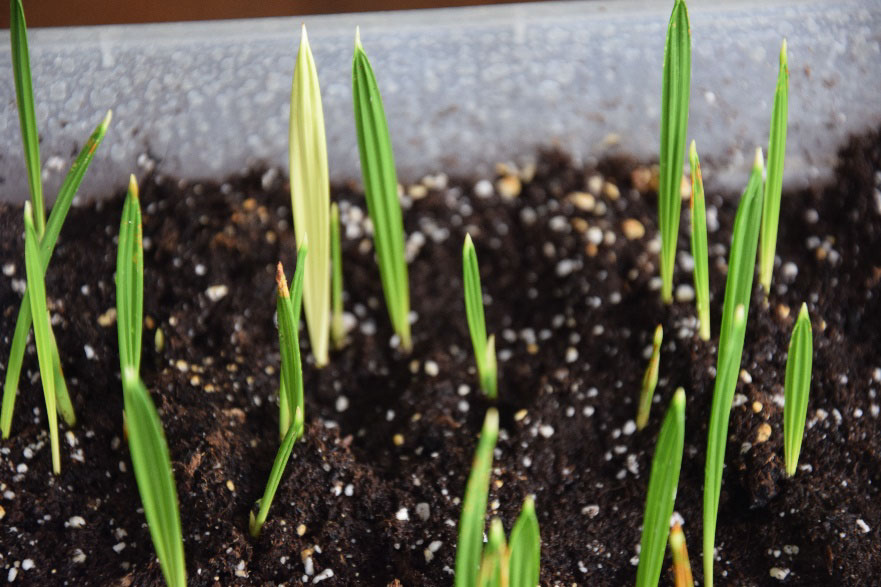
Figure 3: Phoenix theophrasti var. Epidaurus seedlings. Albinism is common in the offspring of palm 2,1
Gender separation
Remarkably, most subpopulations consist of just one gender (male or female trees). Separation of the genders means that pollination is not likely to occur and therefore no seed will be produced so there won’t be a new generation. Subpopulation 1 has only female palms, while subpopulation 3 and 4 are all male. The only solution to this threat is to produce a crossing schedule based on results of a genetic study and to manually pollinate the palms. It is important to cover female inflorescence with isolation bags during the time of pollination to reduce the risk of hybridisation and inbreeding.
Pests and diseases
Pests and diseases pose a major threat to the palms. Many of the planted Phoenix palms in and around Palea Epidavros have already died due to damage caused by the larvae of the red palm weevil (Rhynchophorus ferrugineus). At least four Phoenix theophrasti var. Epidaurus palms have died because of this weevil in the past three years and many Phoenix canariensis have also perished (figure 4).
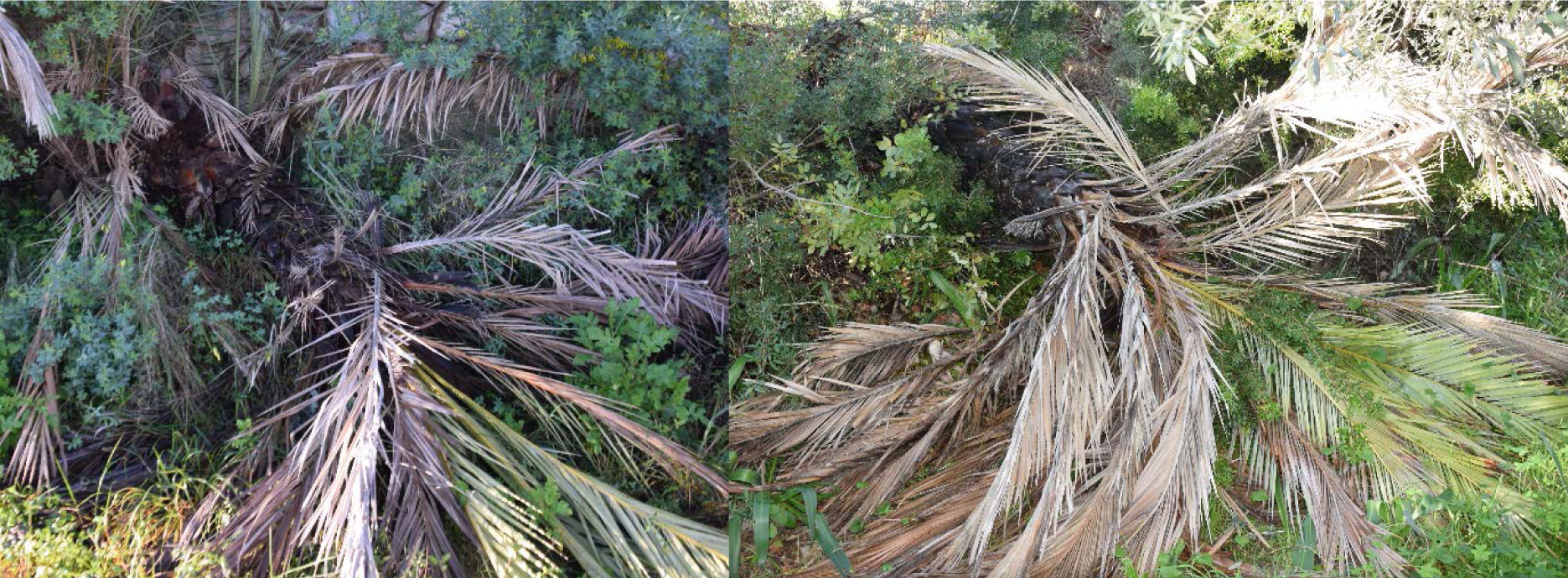
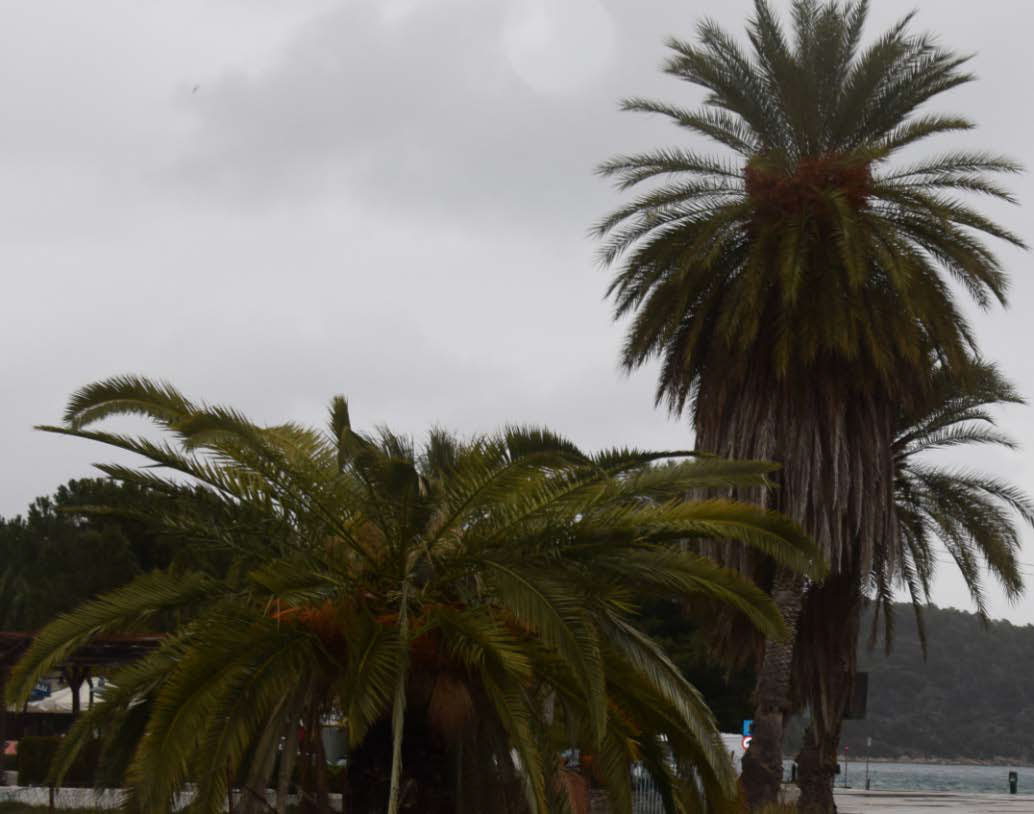
Figure 4: Red palm weevil damage. Above; two recently damaged palms at subpopulation 5 (2019). Below; possibly the only true to type seed producing tree at subpopulation 2 next to an infected Phoenix canariensis (2016).
It is crucial for the survival of these palms to start a large-scale and comprehensive protection strategy for combatting the red palm weevil. The removal of other Phoenix species would be the first step. Then the palms have to be monitored on a monthly basis to notice infections in an early stage. When a palm is infected and the infection is in an early stage it can still be threatened with regular insecticide showers, nematode spraying, systemic insecticide application or manual elimination of the infected leaf bases. Another controversial technique is to light the infected palms on fire, this will destroy all the leaves of the palms but the palms are able to survive this treatment as the Phoenix theophrasti palms demonstrated in the 2010 wildfire in Preveli, Crete.
Other pests and diseases that could pose a threat to the palms of Epidavros are black root rot (Thielaviopsis paradoxa), leaf base rot (Botryodiplodia theobromae) which is also known to infect Citrus, inflorescence rot (Maugniella scattae), leaf spots (Helminthosporium and Alternaria species) and the Texas Phoenix palm decline (TPPD, Candidatus Phytoplasma palmae).
Agriculture and urbanization
The moist Palea Epidavros delta is the perfect habitat for Phoenix theophrasti palms. It is likely that agriculture and urbanization was one of the main reasons for the ancient palm forest to decline. Currently, most of the subpopulations are located on the outermost parts of the delta, where the steep hills make agriculture less practical. Today, almost the whole delta is occupied by agriculture, buildings and roads. About 75% of the surface of the delta is used for agricultural practices, mostly Citrus on the lower parts and olive cultivation on the foothills (Figure 5).
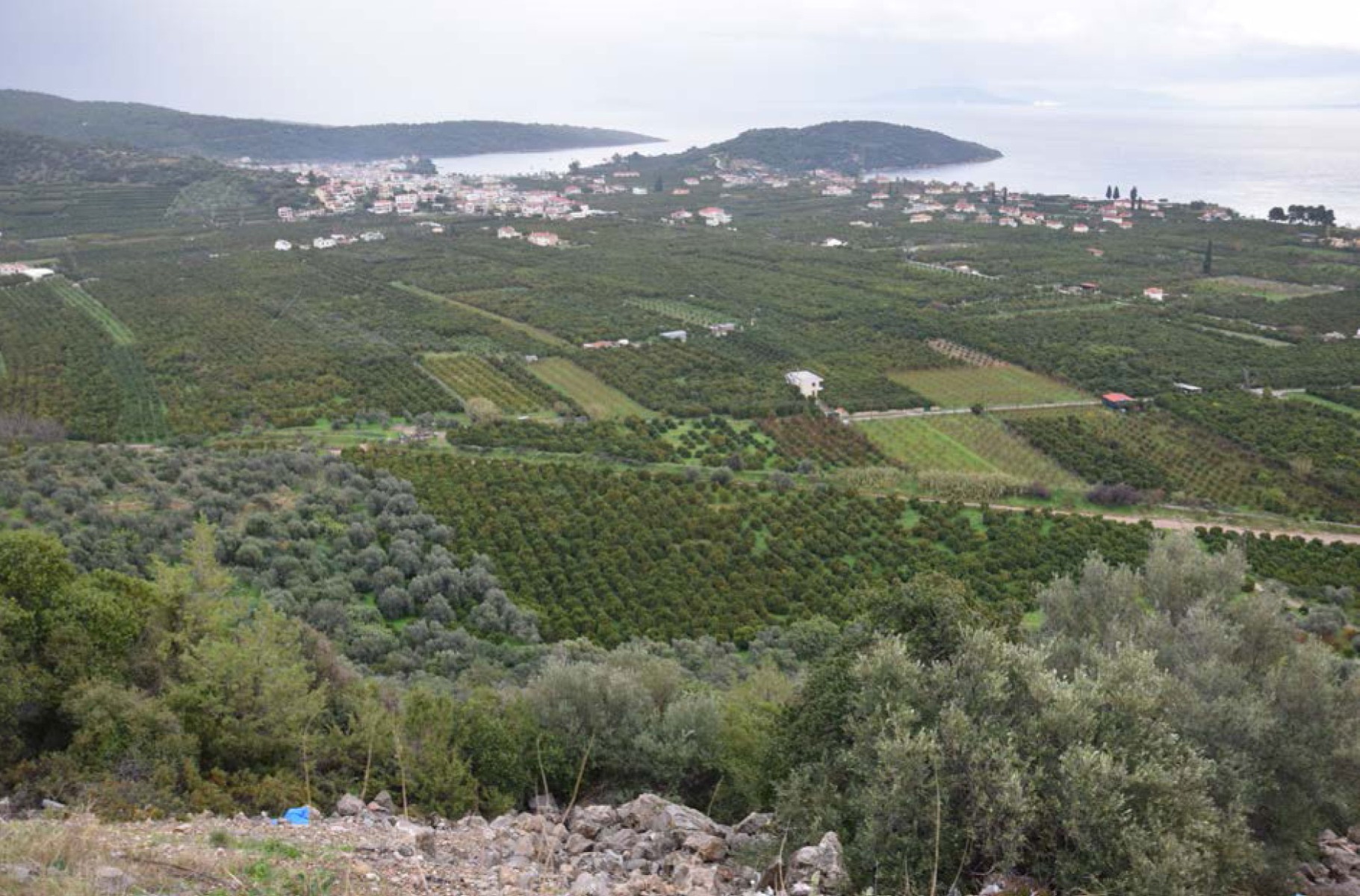
Figure 5: Overview of the agriculture and urbanization of the Palea Epidavros delta, where in ancient times a large palm forest may have thrived.
Conservation strategy
Finally, a personal view and summary of the most important actions that need to be undertaken to ensure the survival and conservation of the Phoenix theophrasti var. Epidaurus palms is added.
To secure the future of the palms of Palea Epidavros rapid human intervention is needed. The number of palms has reduced and numbers are now too low to be self-sustaining on the long term. If no action is taken quickly, it is likely that the last seed producing trees could be lost within years. A comprehensive genetic analysis and breeding strategy needs to be performed to obtain a sustainable genepool with enough genetic variation that could be used as starting material for future reforestation efforts. Since 2016 the initiative was taken to start safeguarding the species by spreading it to European palm enthusiasts, and by starting to multiply the existing genotypes. Seedlings of all seed producing trees have been planted in a protected greenhouse in Haarsteeg, The Netherlands (Figure 6). Here, the palms are save from the previously mentioned threats and could act as a future genebank for conservation and reforestation efforts. Additionally, duplicate seed samples (palm 2,2) have been donated to Kew’s Millenium Seed Bank in Wakehurst to be used for future conservation and scientific work.
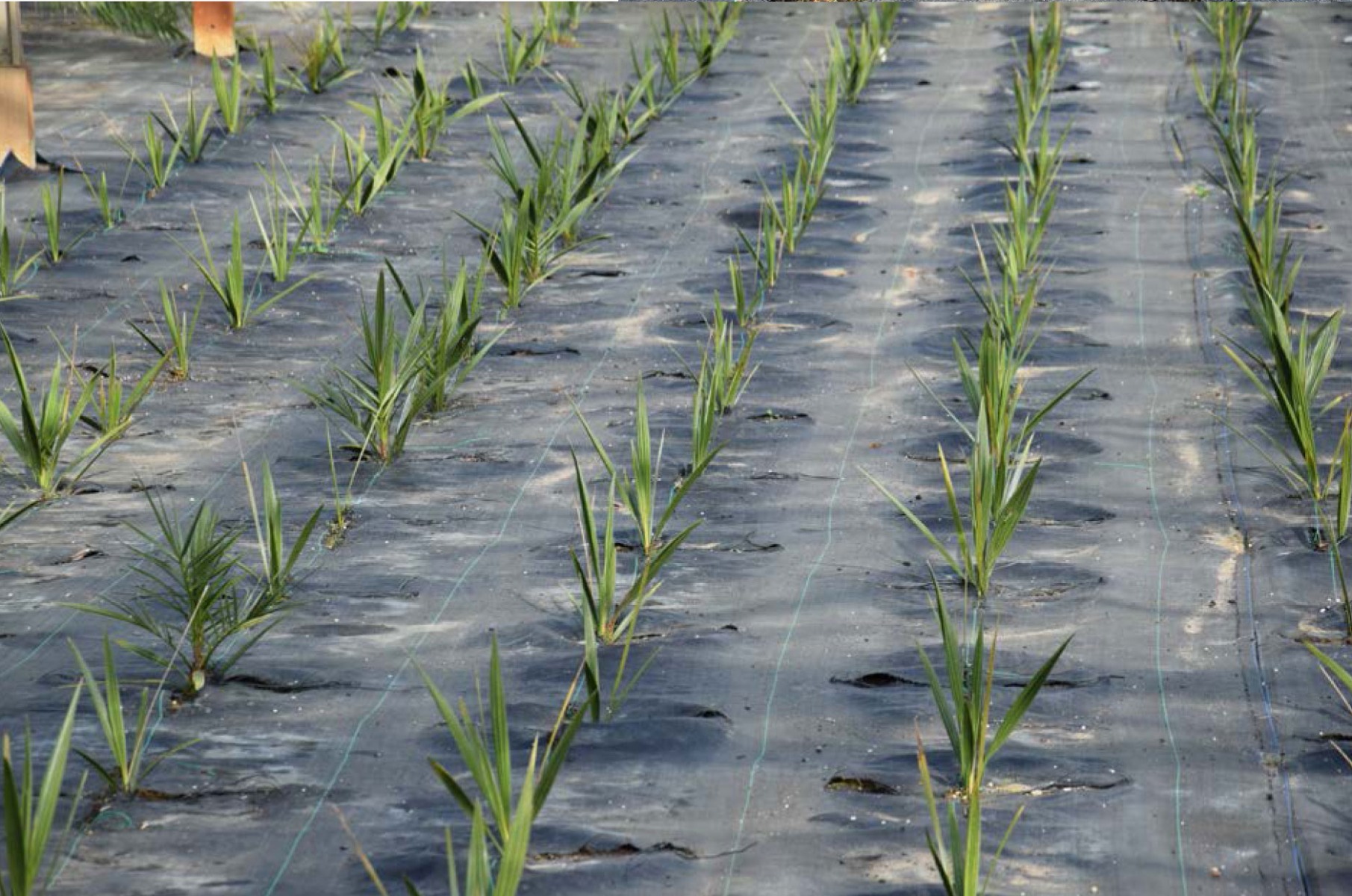
Figure 6: Phoenix theophrasti var. Epidaurus seedlings planted in a protected greenhouse in Haarsteeg, The Netherlands.
Besides safeguarding the species genotypes it is highly important to conserve the palms at Palea Epidavros because it is living ancient Greek cultural heritage. The palms are an economical opportunity for the town of Palea Epidavros. Tourism is becoming increasingly important for the region, the ancient Theatre of Epidaurus and the archaeological site at Mycenae are major tourist attractions. If the ancient palm forest at Palea Epidavros would grow to significant numbers and gain publicity it could also become a popular town for ecotourism and local economy could benefit from these tourists. The +-200.000 Phoenix dactylifera palms at the Unesco world heritage site Palmeral of Elche (Elx) in Spain (Figure 7) is the perfect example of a similar successful and sustainable ecotourism strategy.
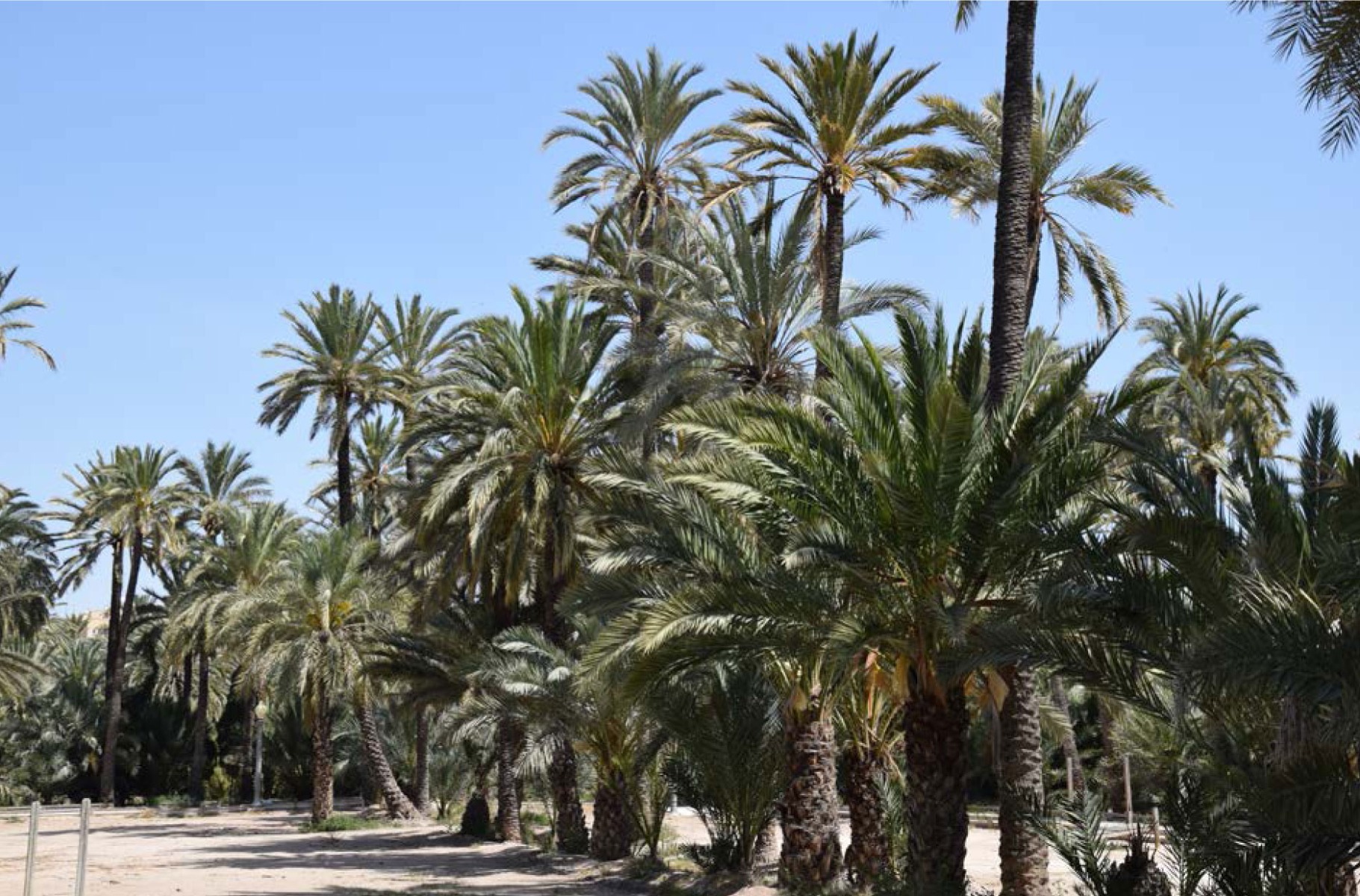
Figure 7: Phoenix dactylifera (Iberica) at the Unesco world heritage site Palmeral of Elche (Elx) in Spain.
When talking to local people from Palea Epidavros about the palms they are usually very enthusiastic and proud of the palms. But it is still crucial to educate the owners of the land where the subpopulations are located about the threats and the importance to start conservation efforts and crossing programs. Similar to Vai, the largest Phoenix theophrasti population in Crete, the palms of Palea Epidavros need to be protected by Greek law to ensure that conservation efforts will not get impeded.
References
Doedens, T, New population of Phoenix theophrasti (Phoenix theophrasti var. Epidaurus) found in Palea Epidavros, Greece moves the species northernmost distribution limit, 2017
Flowers JM, et al. Cross-species hybridization and the origin of North African date palms, 2019
Hughes, P, W, et al. Minimal-Risk Seed Heteromorphism: Proportions of Seed Morphs for Optimal Risk-Averse Heteromorphic Strategies, 2018
Thymakis, N., 2009, Phoenix theophrasti Greek Edition of the Red Data Book (University of Patras)
